#Trading Payoff Structure
Explore tagged Tumblr posts
Text
Trading Strategies Using the Synthetic Call Options
The Synthetic Call options trading strategy is an advanced options trading technique that replicates the payoff of a long call option using a combination of a long stock position and a long put option. This strategy is beneficial for traders who want the benefits of a long call option without actually purchasing the call. In this comprehensive guide, we will explore various effective trading…
#Advanced Options Techniques#Bear Market Strategies#Bull Market Strategies#Cost-efficient Trading#Downside Protection#Financial Trading Tips#Investment Strategies#Long Put Option#Long Stock Position#Market Consolidation#Options Rolling Strategy#Options Trading Examples#Options Trading Strategies#Protective Collar Strategy#Put Spread Strategy#Risk management in trading#Stock market trading#Synthetic Call Options#Trading Flexibility#Trading in Different Market Conditions#Trading Payoff Structure#Volatile Market Trading
0 notes
Text
From Homework to Home/Work (A Body Swap Story)
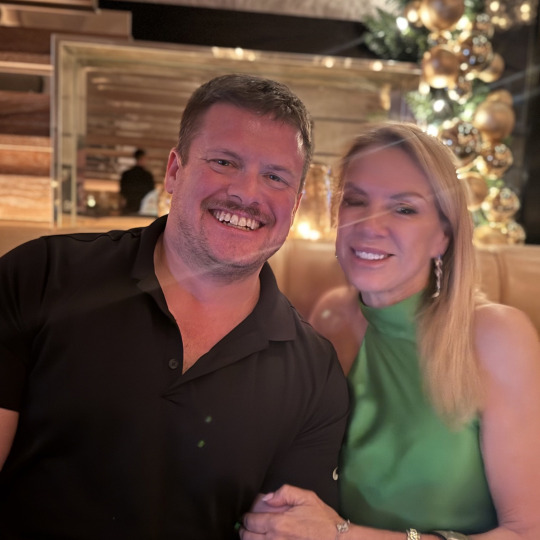
(Dave)
Dave let out a weary sigh as he collapsed onto the worn-out couch in his modest living room. The fluorescent glow of his laptop screen cast a dim light on his exhausted face, highlighting the deep lines of fatigue that had settled over the years. He was only forty, but the weight of responsibility made him feel much older. Being an accountant paid the bills, but the job was monotonous, draining, and unrelenting. Worse still, when he clocked out from work, his real shift began—the role of a single father to his three-year-old twins, Emma and Ethan.
His wife, Laura, had passed away three years ago, leaving him with both the blessing and the burden of raising their children alone. She had died giving birth, and while Dave cherished his kids more than anything in the world, he couldn’t ignore how exhausting it was to do everything on his own. His neighbor, Charlie, often saw him struggling—whether it was carrying groceries with two toddlers clinging to his legs or desperately trying to calm their tantrums in the front yard. Despite his age, Dave felt like he had lived a hundred lifetimes, and he longed for a brief escape from the endless cycle of work and parenting.

(Charlie)
Charlie, on the other hand, was a college student, stuck in a life he found equally unsatisfying. He trudged through his university days with growing resentment, suffocated by coursework that felt meaningless. College, he was told, would lead to a stable future, but all he wanted was to fast-forward to that future already. He envied people with secure jobs, with steady incomes, with lives that weren’t dictated by midterms and last-minute essays. Charlie often saw Dave, exhausted but settled in his life, and wished he could trade places—even if just for a little while.
One afternoon, as Dave absentmindedly pushed his kids on their backyard swings, he glanced over the fence and saw Charlie lounging on a deck chair, scrolling aimlessly on his phone. An idea sparked in his tired mind. Later that evening, he knocked on Charlie’s door, offering him a proposal unlike any other.
“Would you be willing to babysit my kids during spring break?” Dave asked, rubbing the back of his neck. “I’ll pay you—a lot.”
Charlie perked up at the mention of money, but before he could agree, Dave continued. “There’s more to it. I want to swap bodies with you. I’ll be you for a while, and you’ll be me.”
Charlie blinked, sure he had misheard. But when Dave explained further—his exhaustion, his need for a break, his willingness to compensate handsomely—Charlie’s interest grew. The idea was insane, but the payoff? Too tempting to resist. He had always wanted to skip past the struggles of university, to experience a stable, structured life. This was his chance.
The next day, they walked together into the local Body Swap Clinic, a sleek, futuristic facility nestled between a bank and a coffee shop. The receptionist, unfazed by their request, handed them a set of forms. “Standard procedure,” she said. “You’ll experience full consciousness transfer, retaining your own thoughts but fully inhabiting each other’s bodies. The swap will last until your scheduled reversal unless you both agree to an extension.”
Minutes later, they were ushered into separate chambers, and as the machine whirred to life, their vision blurred. A jolt of electricity surged through them, and in an instant, everything shifted.
For Charlie, the transition was surreal. He stood up, stretching Dave’s older, slightly stiffer body. He looked in the mirror and saw Dave’s face staring back at him. He didn’t notice how fit Dave really was until he swapped with him.

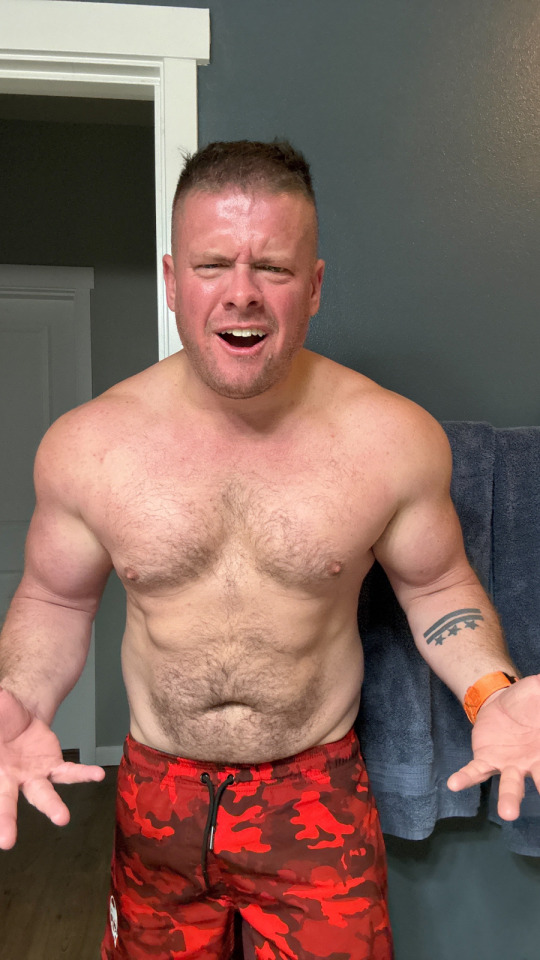
Charlie also discovered a newfound appreciation for fitness. Dave’s body was more muscular and well-built compared to his own, and he found himself enjoying his time at the gym like never before. Lifting heavier weights, feeling the strength in his arms, and seeing the respect from others at the gym boosted his confidence in a way he had never experienced. He relished the power and endurance that came with the older man’s physique, making his daily workouts something he looked forward to.
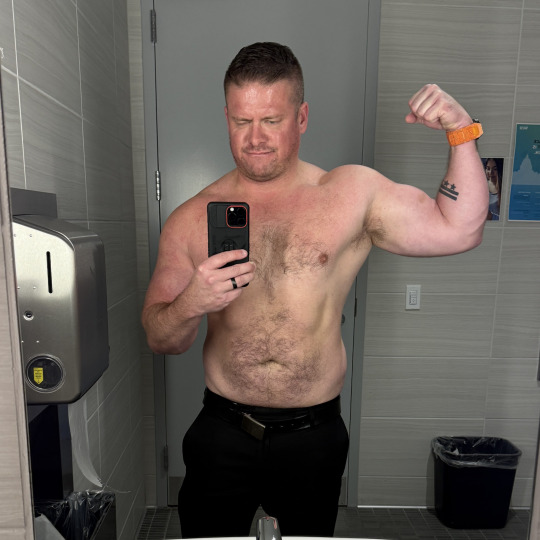
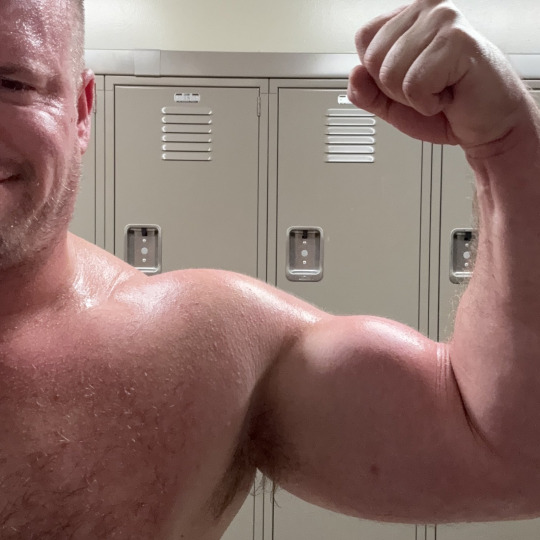
There was a comfort in being Dave, in being needed, in having a purpose beyond just passing exams. As the days passed, a thought gnawed at him—he wasn’t sure he wanted this to end.
Meanwhile, Dave reveled in Charlie’s youth. He’s surprised how much smaller he feels but for some reason, he preferred this than being bigger. Not only that, he was also considerably less hairy. He looked closely at his torso
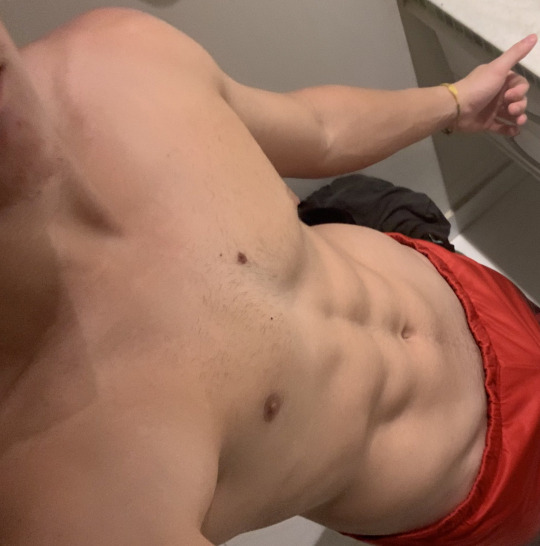
Then took a selfie in front of the mirror.
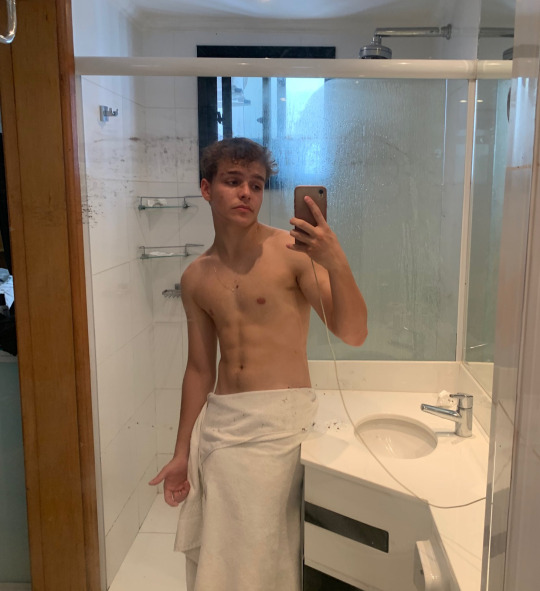
He met up with Charlie’s friends, stayed out late, and did things he hadn’t done in years. The world felt new again—full of excitement and possibilities. He could even sleep in and just be in bed for hours scrolling on his phone.

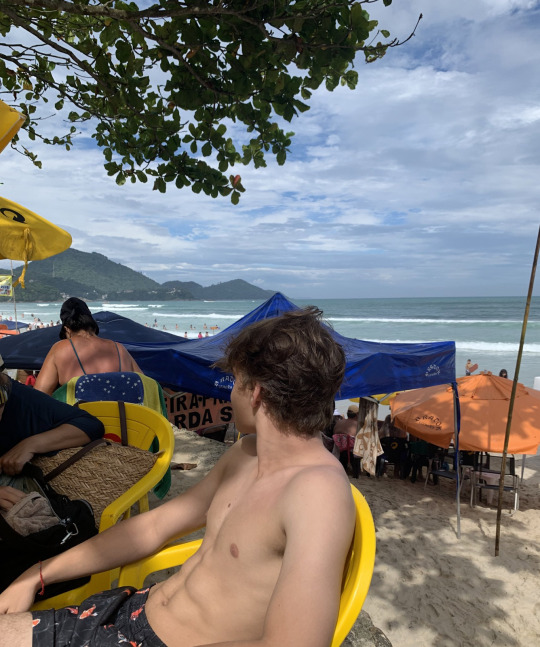
But even as he enjoyed the carefree existence, a whisper of guilt crept in. His kids, his job, his life—everything was waiting for him to return. And yet, the thought of going back so soon felt almost unbearable.
Before spring break ended, they met again. Charlie was the first to speak. “I… I had fun. More than I thought I would.”
Dave nodded slowly, hesitation evident in his eyes. “Yeah… It was nice. Being young again.”
Charlie studied Dave carefully before making his offer. “What if we extended this? Until Christmas, maybe?”
Dave’s heart pounded. He should say no. He should go back. But the temptation was too strong. After a long pause, he whispered, “Alright.”
And just like that, the deal was made. For now, at least, they weren’t ready to return to their old lives.

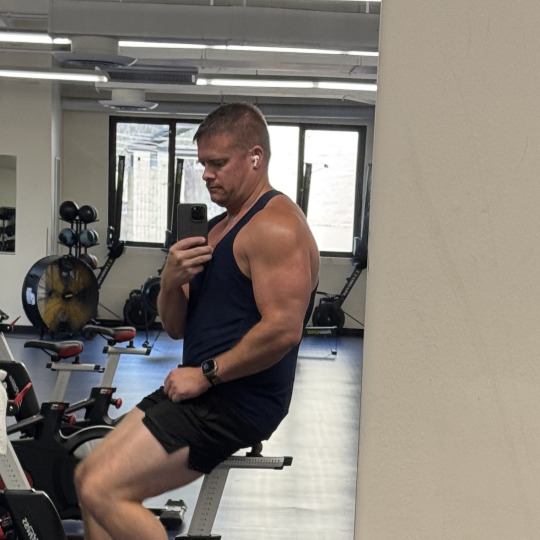

(Charlie enjoying being Dave until Christmas)
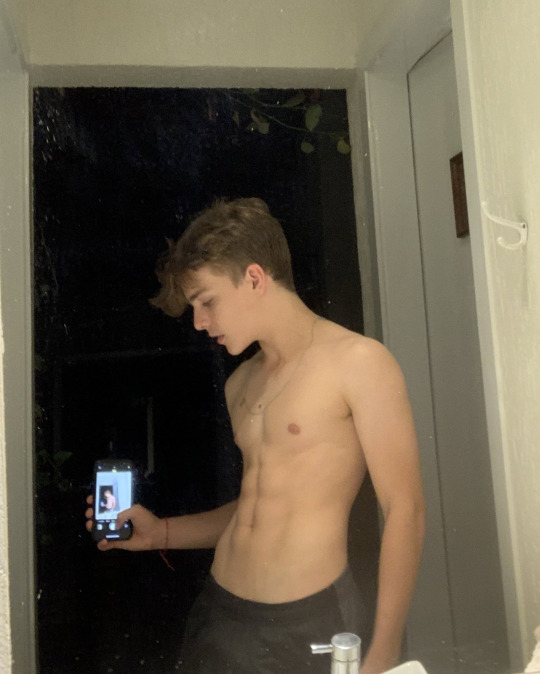

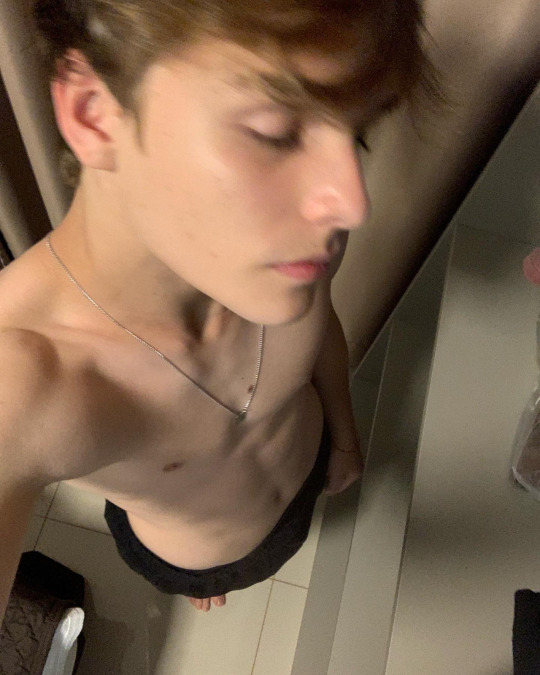
(Dave enjoying being Charlie until Christmas) [PS: Should they swap back or just swap permanently?]
385 notes
·
View notes
Text
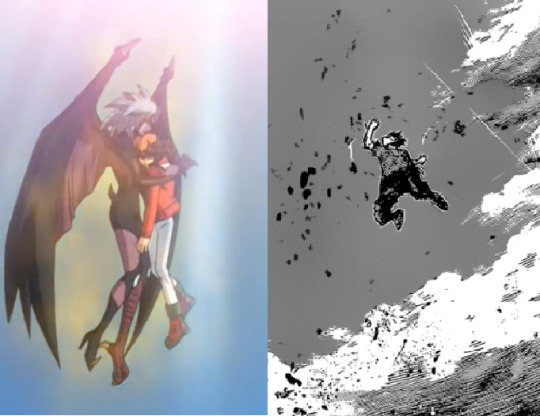
SHIGARAKI VS. YUBEL: HOW TO SAVE YOUR VILLAIN
The failure of Deku to save Shigaraki isn’t just a tragic conclusion for Shigaraki’s arc, it’s also My Hero Academia failing as a story. When I say the story failed, I mean the story has failed to answer any of the questions it asked its audience. It’s themes, character arcs, everything that communicates the meaning of the story to the audience is no longer clear.
Saving Shigaraki was the central goal of not only the story itself, but the main character Deku. By failing in its goal you can’t call this a good ending. In order to illustrate why this goal of saving the villain is so important to both Deku’s character and the central idea of MHA, I’m going to provide a positive example in Yu-Gi-Oh GX were the main character Judai successfully saves their villain. One of these stories fails, and the other succeeds. I will illustrate why under the cut.
BROKEN THEMES = BROKEN STORY
When artists draw they have to consider things like perspective, anatomy, shading, light, coloring. Drawing has rules, and it’s hard to produce good art without knowing these rules beforehand. If I draw something that has bad anatomy, you can criticize me for that.
Writing has rules, just like drawing. The rules of storytelling are important because writing is an act of communication. You can write whatever you want, just like how you can draw whatever you want, but if you break the rules the audience won’t understand what you are trying to communicate.
When I refer to MHA as a broken story, I am referring to the fact that it has broken the rules of storytelling. As this youtuber explains.
“I guess we should first define what broke and broken even means in this context. Has the story turned into an unintelligible mess? Not really. Value judgements aside, the narrative is still functional and fulfills the criteria of being a story. So how can a story that still functions be broken? Maybe to you it cannot. But to me a story that is still functional isn’t enough. What I mean when I say MHA is broken is that it’s lost something crucial. A codifying style of structure, pacing and payoff that until a certain point was the core of its identity.”
I could launch into a long-winded explanation of what themes are, but for the sake of simplicity I like to define themes in terms of “Ask, and answer.” The author asks a question to the audience, and then by the end of the story provides an answer. The audience is also invited to come up with their own answer which prompts them to think about the story on a deeper level. The question both MHA and GX are asking both its main characters and the audience is “Can you save the villain?” with the additional complicated question of “Should you save the villain?” This post will detail how both stories go about answering those two questions, and more importantly why those answers matter for the story.
With Great Power… You know the rest.
My Hero Academia and Yu-Gi-Oh Gx are actually similar stories once you get past their superficial differences. MHA is a story with way better worldbuilding, compared to a society where everything revolves around the trading card game, and people go to school to be better at a trading card game.
However, if you get past that. They are both bildungsroman, stories about the main characters growing up into adults. They both have an academy setting where the goal is for the main character to graduate and enter the adult world. They are both shonen manga. GX is the sequel of Yu-Gi-Oh a manga that ran in Shonen Jump the exact same magazine as MHA. The biggest point of comparison is their main characters, who both start out as young and naive who are driven by their admiration of heroes. Deku is a fan of All Might who wants to become a hero despite not having a quirk, because he loves All might who saves everyone with a smile. Judai’s entire deck archetype revolves around “Elemental Heroes’ and later “Neo-Spacians” who are all based on popular sentai heroes like ultraman.
The central arc for both characters is to grow up. Growing up for both of them not only requires figuring out what kind of adult they want to be, but also what kind of hero they want to be.
Now I’m going to drastically oversimplify what a character arc is.
A character arc first starts out with the character being wrong. Being wrong is essential because if the character is right from the beginning, then there’s no point in telling the story. A character often holds the wrong idea about the world, or has some sort of flaw that hinders their growth. The narrative then needs to challenge them on that flaw. It usually sets up some kind of goal or win condition. That flaw gets in the way of a character “winning” or achieving their goal, so they need to fix that flaw first. If their ideals are wrong, then they need to think about what the right ideals are. If they’re too childish, they need to grow up. If they have unhealthy behaviors or coping mechanisms, they need to unlearn it and require better ones. Otherwise, that flaw will keep sabotaging them until the end.
I’m borrowing the word “win condition” from class1akids here because it’s an incredibly appropriate terminology. Midoriya needs to do “x” in order to win, otherwise this victory doesn’t feel earned. The “x” in this case is usually character development. As I said before, a story where the main character hasn’t changed from beginning to end feels pointless. Especially in Deku’s case, he was already a brave, strong hero who would charge right into battle and defeat the bad guys in chapter one, so him defeating Shigaraki in a fist fight doesn’t represent a change.
The story sets up not only “What does the hero need to do to win?” but also “How does the hero need to change in order to win?” A character either meets these requirements before the end of the story, or they don’t and usually this results in a negative ending.
MHA in its first half quite clearly set up both the final conflict of saving the villains, and also that saving the villains is its “win conditions.” The hero shouldn't be allowed to win without first fixing this flaw.
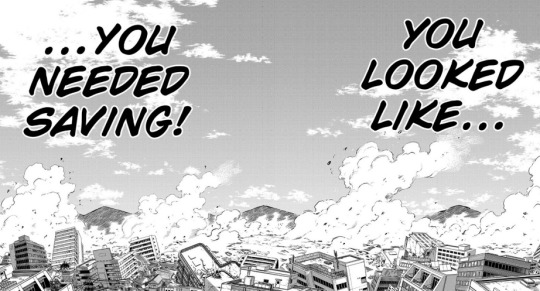
From this panel onward the central question Deku is forced to answer shifts from “Am I strong enough to defeat ShigarakI” to “Can I save Shigaraki?” However, much earlier than that All Might goes on to basically set up the win conditions of what makes the ultimate hero as someone who “Saves by winning, and wins by saving.”
All might: You can become the ultimate heroes. Ones who save by winning, and win by saving.
Therefore the story has set it’s criteria for what kind of hero Deku needs to become. If he wins without saving, then he’s failed to become what the series has set up as the Ultimate Hero.
Shigaraki and Yubel aren’t just narrative obstacles, or boss monsters to be killed like in a video game. They are narrative challenges, which means that the character can’t grow in any way if they don’t answer the challenge presented by the characters. They are villains who actively resist being saved, to provide a challenge for two heroes who define their heroism by saving others. The challenge they pose adds a third question to the story and the main characters.
"Can I save the villain?"
"Should I save the villain?"
"If I don't save the villain, then can I really call myself a hero?"
In other words the decision they make in saving, or not saving their final antagonist defines what kind of hero they are. In Deku’s case it’s even more critical he defines what hero he wants to be because the MHA is also a generational story, and several of the kids are asked to prove how exactly this generation of heroes is going to surpass the last one. The kids growing physically stronger than the last generation isn’t a satisfactory answer, Deku getting strong enough to punch Shigaraki hard is not a satisfactory answer, because we are reading a story and not watching a boxing match.
I’m going to focus on the last two questions though for a moment. Many people who argue against saving villains like Shigaraki argue he is a mass murderer and therefore isn’t worthy of salvation. However, the act of saving Shigaraki isn’t a reflection of Shigaraki himself, but rather the kind of hero Deku wants to be. It all boils down to Spiderman. In the opening issue of Spiderman, teenage Peter Parker is bitten by a radioactive spider and suddenly gains super strength, the ability to stick to walls along with other powers. However, being a teenager he uses these powers selfishly at first. He doesn’t feel the obligation to use his powers for other people, and therefore when he sees a robbery happening right in front of him he lets the robber go. However, because he lets the robber go, the robber then attempts to hijack a car and kills his Uncle Ben in the process. If Spiderman had stopped the robber then he might have prevented that from happening. He had the power to stop the robber, but he didn’t feel responsible or obligated to save other people. As a result Uncle Ben dies. It’s not enough to have power, ti’s how you use that power that reflects who you are, therefore: “with great power comes great responsibility.”
The choice to save Shigaraki actually has little to do with whether or not Shigaraki is redeemable, but rather how Deku chooses to use his power, and what he thinks he is responsible for reflects who Deku is as a person. Deku himself also clearly outlines how he wants to use his power, that One for All is a power for saving, and not killing.
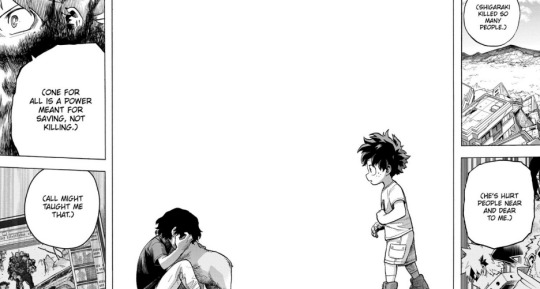
How he uses his power reflects Deku’s ideal in saving others, and therefore if he doesnt use his power to save, then he’s failed to live up to his ideals. It's not whether it's morally right to save a murderer like Shigaraki, but rather the way Deku wants to choose to use his power. It's about whether he feels the responsibility to save others.
Judai explores an incredibly similar arc to Deku. They are basically both asked what kind of responsibilities a hero is supposed to have, which is also a metaphor for growing up to handle the responsibilities of adulthood. As both characters start out with incredibly naive and childish ideas about what a hero is. Therefore realizing what a hero is responsible for is key to them growing as a character. However, Judai is different from Deku. In some ways he’s more like Bakugo. Judai is a prodigy who’s naturally good at dueling. He doesn’t duel to save others, but rather because duels are fun and he’s good at it. He’s very much like Bakugo, who admired All Might as a hero just as much as Deku did, but admired the fact that he was strong and always won rather than he saved others.
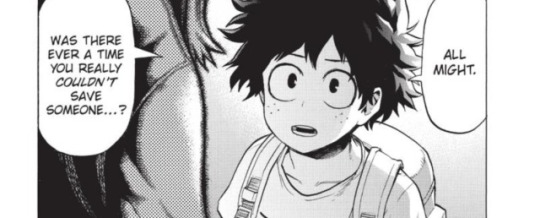
However, I would say both Deku and Judai are questioning what a hero is responsible for. They are both asking if they have the responsibility to use their power to save others. If they have to fight for other people, just because they have power. His first big challenge as a character comes from Edo Phoenix, who calls out Judai for not thinking through what it means to be a hero, and what responsibilities heroes carry. Judai duels because he thinks it’s fun. He will show up to duel to help his friends, but that’s because he’s the most powerful person in the group. Even then it’s because he finds fighting strong opponents to be enjoyable. Bakugo will beat up a villain, but for him it’s more about winning then if the action will save someone or not.
Judai is more often than not pushed into the role of being a hero, he doesn’t play the hero because he’s a particularly selfless person, and he’ll often avoid responsibility if not forced. He has power but no sense of responsibility and the narrative calls them out as a problem.
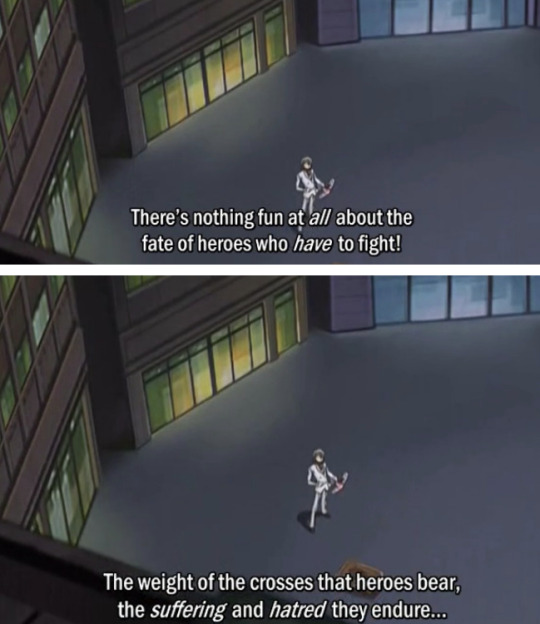
Edo: Can you even fathom that, Judai?
For Judai, he can’t understand the responsibility of being a hero. For Deku, he idealizes heroes so much he can’t understand that there are people out there the heroes have failed to save. These two callouts towards Deku and Judai are discussing similar because they’re both discussing where a hero’s responsibilities lie. Is a hero responsible for saving everyone? Is someone strong like Judai responsible for using their strength to help other people?
Judai’s arc continues into the third season where he’s not shown to just be naive but ignorant. He’s not just childish, he actively resists growing up because he doesn’t want to take on adult responsibilities.
THe same way that Deku just decides not to think about whether or not All Might failed to save people in the panels above. However, in Judai's case he's actively called out for his choice to remain ignorant.
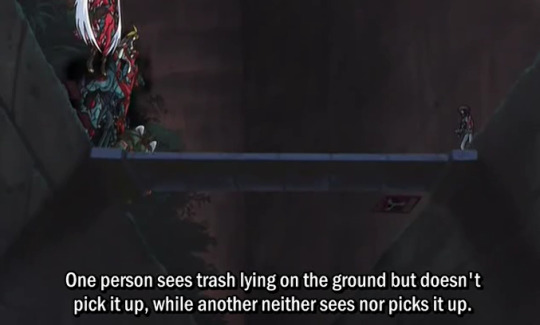
Satou: Now, which one is at fault? Judai: Isn’t it the guy who saw it, but didn’t pick it up. Satou: Not quite. If one is aware of the trash that fell, it may be picked up someday. But there is no possibility fo the unaware one ever picking it up. Judai-kun you are the foolish one unaware of the trash that has fallen. Judai: Are you calling me out for how I am? Satou: Your behavior towards me was atrocious. The worst was attending class only for credit, even if you were there you only slept. Judai: Yeah, I know. I was all bad, but it wasn’t that big a- Satou: It is important. You see, one by one, the students inspired by your attitude were losing their motivation. Now if you were a mediocre duelist, then this would not be an issue. Satou: However, you are the same hero who defeated the three mythic demons. Every single student in the academy admires you. You should have been a model for this academy. Judai: Me, a role model? Are you kidding? I just do whatever I feel like doing. Satou: Great power comes with great responsibility. Yet, as you remain unaware of that, you’ve spread your lethargy and self-indulgence.
seems like a minor issue, but look how Judai responds to the accusations. “I just do whatever I feel like doing.” Satou is arguing that Judai should pay attention to the influence he has on others because of his power, because how he chooses to use that power affects others. However, Judai chooses to actively not look at the consequences of his actions because he doesn’t want to take on that level of responsibility, and therefore he’s looking away from the trash.
While it seems like it doesn’t matter in Satou’s specific example, not thinking of the consequences, or how you use your power can have unexpected consequences. Spiderman doesn’t feel like it’s his responsibility to stop a bank robber, and that bank robber shoots his uncle. You could still argue it’s not Spiderman’s responsibility to stop every crime in the world, and I guess no one owes anyone anything from that point of view - but Spiderman failing to act responsibility had the consequence of directly hurting someone else.
Spiderman has to live with that consequence because it was his own Uncle that was hurt. This is where we really reach the duality of Judai.
In GX, Judai is, symbolically speaking, The Fool of the Tarot Deck, the Novice Alchemist — a person brimming with infinite potential, yet one who is also supremely ignorant, who walks forward with his eyes closed and often unknowingly causes harm in his great ignorance. In this, he is very much the embodiment of the faults we most commonly associate with teenagers — selfishness, recklessness, shallowness, a lack of dedication or empathy when it’s most needed. Like most people, he has good traits that work to balance out some of the above, but his narrative path through GX ends up being that of the flawed hero undone by his faults — and then that of the atoner, the repentant sinner. In his case, the mistakes of his teenage years are the catalyst for his growth from a boy into a man burdened with duty and purpose. Judai is someone with infinite potential, with great power, but also ignorant on how he should use that power, and that makes him an incredibly flawed hero who needs to learn how that power should be used.
Deku similarly exists in a society where heroes deliberately turn a blind eye to the suffering of a certain type of victim. Shigaraki’s speech heavily resmebles Satou’s speech about garbage on the side of the road.
Shigarali: "For generations you pretended not to see those you coudln't protect and swept their pain under the rug. It's tainted everything you've built."
Deku shares Judai’s ignorance, because he’s not only a part of a system that doesn’t even see trash on the side of the road, but he also worships heroes so much that he’s incapable of criticizing them. If Deku saw the flaws of heroes, but at first didn’t have the courage to speak out, but eventually gained the courage that would be one thing. However, if he doesn’t see the flaws of heroes, then the problem will never be fixed.
There are also consequences for both Judai and Deku failing to use their powers responsibly. These consequences take the form of the villains who came about because of all of society’s ignorance to the suffering of victims (Shigaraki) and because of the main character’s ignorance to their suffering (Yubel). Shigaraki and Yubel are also explicitly victims that the heroes failed to save, turned into villains who are active threats to the heroes.
Should I save the villain?
The answer is yes, because the decision to save is reflective of the kind of hero each character wants to be. Each story clearly sets up that Deku and Judai aren’t punisher style heroes who shoot their villains, they are being set up as heroes who save. Deku needs to “save by winning.” As for Judai, a big deal is made of Judai’s admiration for another character Johan who represents a more idealistic kind of hero. Johan unlike Judai is someone who duels with a purpose, something Judai outright says he admires because he’s empty in comparison.
Judai: Johan what have you been dueling for? See, it’s about fun for me… Well, for the surprise and happiness too. I guess I do do it for the fun. Sorry, I guess I put you on the spot by asking out of nowhere. Johan: What’s this about Judai? Judai: It’s nothing. Johan: I suppose there is one goal I have. Johan: Even if someone doesn’t have the power to see spirits, they can still form a bond with a spirit. That’s why I do it for people like him. [...] Johan: I'll fight for everyone who believes in me, and I'll do it with my Duel Monsters. Judai: I'm jealous you've got feelings like those in you.
Becoming a hero who uses their power to help others isn’t just a goal the story sets for Judai, it’s a goal that Judai sets for himself because of his admiration for Johan. Johan represents the idealistic hero Judai wants to be, but is also held back from because of his personality flaws. Johan represents the kind of heroic ideal that Deku is aspiring to be.
Johan’s ultimate goal isn’t punishing the wicked, but to use his power to save others.
Johan: Judai, it was my dream to save everyone through my dueling!
The story sets up the idea that it’s not enough for Judai to simply be strong, he’s also challenged to become a savior who uses his power to help others like Johan. Deku needs to “save by winning” and Judai needs to “Save everyone through his dueling.” However, Johan also adds another condition to what saving means. His idea of saving isn’t to defeat a villain, but rather his dream is to help connect spirits and humans together, even if there are humans who can’t see spirits. Johan doesn’t save people with the power of physical force, but rather the power of human connection.
Should I save the villain?
Here the answer is "Yes", because wants to become more like Johan someone who uses their power to help others not just for themselves. Then we reach the third question
If I don't save the villain, can I really call myself a hero?
It once again comes to power and responsibility. Heroes have great power, and they are responsible in how they use that power, if they use it irresponsibly then there are consequences. Shigaraki wants to destroy hero society, because the heroes irresponsibly use their power to turn a blind eye to everyone’s suffering.
People suffer when heroes fail to live up to their responsibilities. The entire conflict of season 3 is created by Judai failing to save Yubel. If Judai had helped Yubel when they most needed it, instead of abandoning them, then Yubel would never have been twisted by the light of destruction, would never have attempted to teleport the school to another dimension, would never have attacked all of JUdai’s friends.
These consequences matter. Deku can turn his eyes away from Shigaraki’s suffering, but let’s say a hero failed to stop a robbery, or rather he didn’t even try, and because of that his mom was shot and died in the street. Would Deku consider the man who failed to stop a bank robbery a hero? When Spiderman let a bank robber go instead of trying to stop him, was he being a hero in that moment? Both the stories and the characters themselves have defined heroes as people who use their powers to save others, therefore if Judai and Yubel fail to save their villains then they can’t be called heroes by the story’s own definition. Now let’s finally return to the question of "Can I save the villain?"
Was there ever someone you couldn’t save?
m going to start with Yu-Gi-Oh Gx as a positive example of how to save your villain. Gx works for two reasons. One, it’s established from the start that Yubel isn’t beyond salvation, and two, it makes it so Judai can’t win without saving Yubel. The conflict of the story does not end until Judai makes the decision to save Yubel. In some ways the writing is even stronger because Judai is directly responsible for the pain and suffering that Yubel went through that turned them into a villain in the first place. Yubel isn’t just a victim, they’re specifically Judai’s victim.
Yubel is a duel spirit who is also essentially Judai’s childhood friend. A duel spirit just like the kind that Johan wants to save. During their childhood Yubel got too overprotective of Judai, and started to curse his friends for making him cry or upsetting him in any way. Until everyone Judai’s age started avoiding him and Judai became all alone with only Yubel for company. Judai’s decision was to abandon Yubel at that time. He took the yubel card and shot them into space, hoping that being bathed in space rays will somehow “fix” what was wrong with them. I know that’s silly but just go with it. Judai abandoning Yubel had the unintended consequence of Yubel being subjected to the light of destruction, a corrupting light that subjected Yubel to years of pain. This pain literally takes the form of Yubel burning alive.
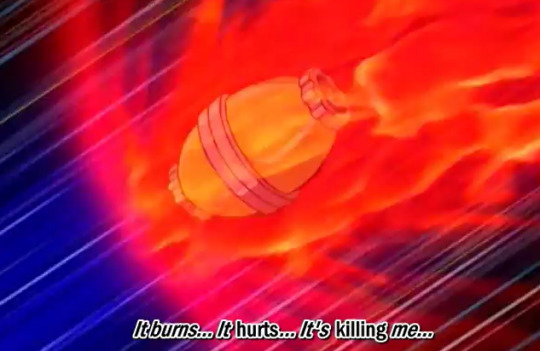
Yubel connected to his dreams called out for Judai every night, only for Judai’s parents to give him surgery that repressed his memories of Yubel causing him to forget them entirely. Yubel then spent the next ten years alone in space, continuously subjected to painful torture, with their cries for help being ignored.
"I was suffering even as you came to forget about me..."
Yubel is then met with the question of how can Judai treat them this way if they loved him so much? As from Yubel’s perspective, they’ve only ever tried to protect Judai, only for Judai to not only throw them away, but subject them to painful torture and ignore their cries for help. Judai effectively moves on with his life, goes to duel academy, makes friends while Yubel is left to suffer in silence all but forgotten. This is where Judai’s ignorance has serious plot consequences.
It’s not just the pain that Yubel endured that made them snap. It’s that their pain went ignored.
Yubel holds out the faint hope that Judai will answer their calls fro help until they finally burn up upon re-entry into earth’s orbit. At which point they’re left as nothing more than a single hand crawling on the ground. Yubel who cannot fathom why Judai would cause them so much pain, and then forget about them, convinces themselves that Judai must be causing them pain, BECAUSE he loves them.
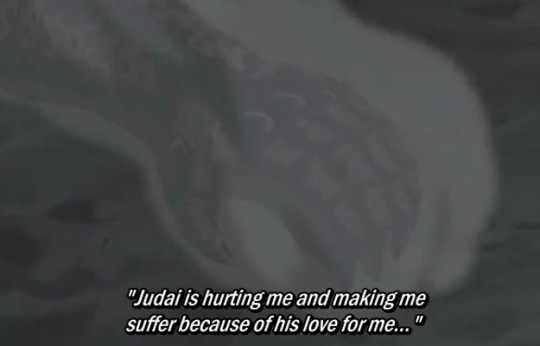
But you see, I couldn't possibly forget about you in the time that I've suffered...
Judai is allowed to move on with his life, to make friends, to spend the next ten years doing so while Yubel is subjected to ten years of agony. When they finally escape their painful torment, they see all the friends Judai has made while they’re left alone and forgotten. However, Yubel’s goal isn’t revenge. Rather, it’s to make Judai share and recognize their pain. WHich is why I said it’s not the fact that they were made to suffer, but their suffering is ignored. Yubel’s entire philosophy revolves around the idea that sharing pain is an expression of love, and that they and Judai share their love for each other by hurting each other.
"That's why I sought to fill all those linked to you, your world, with both sadness and anguish..."
For Yubel, making all of Judai’s friends suffer and Judai themselves suffer is a way of making them and Judai equals again. They want to show “their love” for Judai, but it’s more about forcing Judai to recognize the pain he’s caused them by forcing him through the same pain. Yubel’s philosophy of sharing pain is actually a twisted form of empathy.
They’re not entirely wrong either, that even people who love each other can cause each other pain, and that if one person is suffering alone in a relationship or the suffering is one-sided then there’s something wrong with that relationship.
Yubel: I get it now… You weren’t in love, with Echo. Yubel: No.. you may have loved her just enough to clear the conditions in palace for you to control Exodia, but the you didn’t truly love each other. Yubel: You were only unfairly hurting her, while you stayed unharmed. You wouldn’t suffer. You wouldn’t suffer. You wouldn’t be in pain. Amon: What are you getting at? Yubel: I’ve been hurt! I’ve suffered! I’ve been in pain. That’s why I’m making JUdai feel the same things I did!
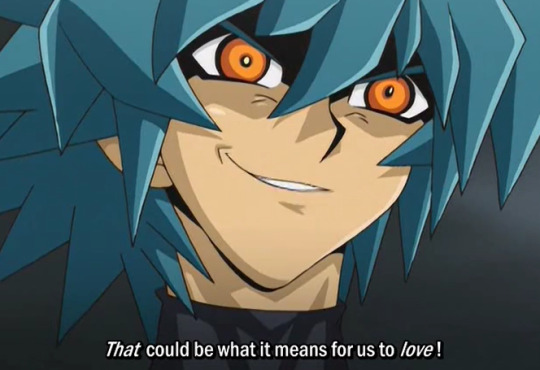
Yubel’s twisted theory of love, is a pretty thinly veiled cry for empathy.
They break out into tears when talking to Amon about the way they’ve hurt and suffered. They clearly state upfront that their goal is for Judai to recognize their love. One of the first things they say to Judai is a plea for Judai to remember them.
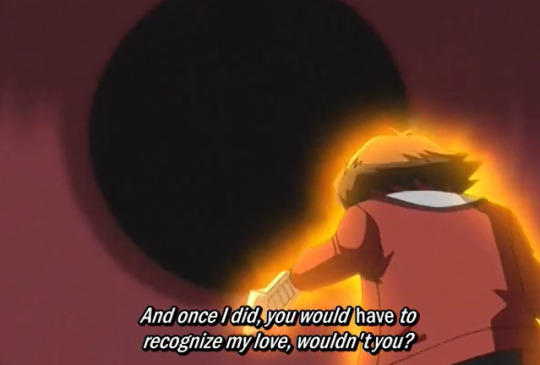
Yubel is presented as a very human character suffering through a lot of pain throughout their entire villai arc, they break down into tears multiple times, they cry out in agony, they're visibly suffering and you see their mental walls begin to break down when Judai denies them any empathy.
Yubel is actually incredibly clear and straightforward about their desire to be saved by Judai. However, Judai doesn’t lift a single finger to help Yubel the entire arc, even though they themselves admit they are directly responsible for Yubel’s suffering but they helped create who they are today.
Judai plunges into a different dimension and gives up everything to save someone, but it’s Johan, not Yubel they try to save. You have Johan, the perfect friend, and perfect victim that Judai gets obsessed over and will not stop at anything to save, and then you have Yubel, the imperfect victim that is actively harming Judai and all of his friends that Judai chooses to ignore. The whole season Judai only focuses on saving the perfect victim Johan, and this is clearly shown to be a flaw. Judai doesn’t just ignore Yubel to save Johan, he also ignores every single one of his friends.
Judai only caring about saving Johan, and deliberately ignoring and abandoning the friends who came with him to help, essentially abandoning them the way he did Yubel leads to another consequence. After he abandons them they get captured, rounded up, and actually die and become human sacrifices.
Losing his friends, causes Judai to snap. Judai becomes the supreme king and decides power is all that matters; he starts killing duel spirits en masse in order to forge the super polymerization card. Which means being left alone, suffering alone, being abandoned by everyone causes Judai to snap the exact same way that Yubel did.
In fact Judai is only saved from his darkest moment, because two of his friends sacrifice their lives, trying to get through to him and appeal to his humanity. At that point Judai’s friends could have just chosen to put him down like a mad dog, to punish him for the amount of people he’s killed, but instead they try to save him because of their friendship.
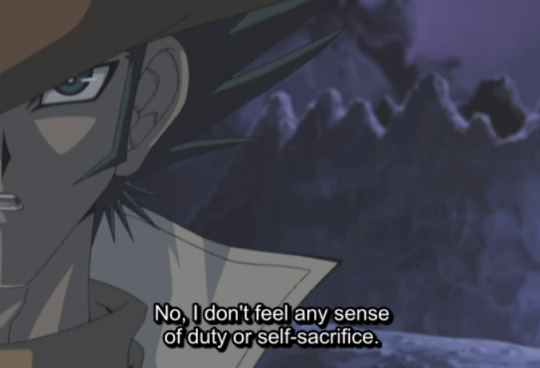
I just want to save my friend. That is all.
By the time Judai is facing Yubel in their final fight, Judai doesn’t have the moral highground against Yubel in any way whatsoever. They’ve both lashed out because of the pain they endured and killed countless people in the process of lashing out. The only real difference between them is that Judai is lucky. He had friends to support him at his lowest point, while Yubel didn’t. Does Judai learn from Jim’s example, and go out of their way to save Yubel the same way they were saved because Yubel is still a friend? Nope, Judai tries to kill Yubel at this point.
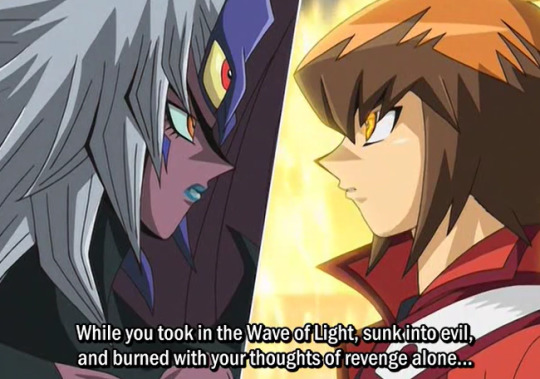
I made a lot of friends... And they all taught me something… real love is wide enough, large enough and deep enough to fill the universe. Your so-called love is only a conceited delusion.
Like, Judai, sweetie baby honey darling. How was Yubel supposed to make friends when they were floating in the empty void of space?
Judai hasn’t learned, they are still ignorant, and still turn a blind eye to Yubel’s suffering. After all if his love is wide enough, large enough,and deep enough to fill the universe then why don’t thy have any room in their heart whatsoever for empathizing with Yubel?
Judai making friends while Yubel was trapped in space doesn’t make Judai a better person than Yubel, it makes Judai lucky. Judai doesn’t even appreciate that luck, because he treats his friends like garbage. It’s not about whether Yubel is worthy of salvation, because Judai is a mass murderer and his friends still went to great lengths to save them anyway. It’s that Judai doesn’t want to empathize with Yubel, because they still want to remain ignorant and irresponsible. Judai wants to continue playing hero, with a very black and white definition of what a hero is. By this point Judai’s killed lots of people, but if he makes Yubel the villain in the situation, he can keep playing hero. He doesn’t have to look at himself and what he’s done, because blaming everything that happened on Yubel and then putting Yubel down like a mad dog allows Judai to absolve his own guilt. Judai practically ignores Yubel’s cries for help, even when Yubel spells it out for them.

I couldn't have lived with the heartache unless I felt that I was being loved...
At this point Yubel themselves acknowledges that their love was just a delusion. That it was a coping mechanism, because they couldn’t live with all the pain otherwise. WIthout it they would have just died, which makes Judai unmoved. The implication here is that Judai thinks yes, Yubel should have just died in that crater. It would have been easier for Yubel to die a perfect victim, then for Yubel to crawl out of that crater and go on to hurt other people. While that may be true the same can be said for Judai - it would have been better if Judai died rather than become the Supreme King. His friends could have put him down like a mad dog, you could have even called that justice - but they didn’t. Judai making no attempt to save Yubel isn’t because he thinks it’s morally wrong to save someone who’s killed as many people as Yubel has, or because he thinks he can’t forgive Yubel, it’s because Judai is taking the easy way out. Johan is a nice, easy victim to save, because he’s Judai’s perfect boyfriend, while Yubel is a complex victim that requires Judai to understand their suffering. Even the act of saving Johan isn’t about Johan himself, it’s about the fact that Judai feels guilt over Johan’s disappearance. What Judai wants isn’t really to save a friend, but to stop feeling guilty over that friend. Judai isn’t just disgusted by Yubel’s actions towards his friend, he also wants to avoid the guilt he feels over causing all of Yubel’s suffering, because it requires acknowledging the complex reality that he is both victim and perpretrator in this case, just as Yubel is both victim and perpetrator.
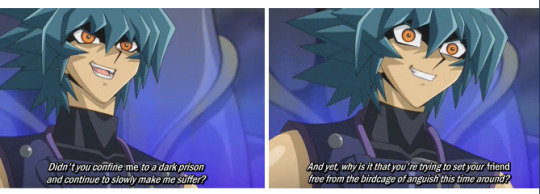
So how can an arc where Judai doesn’t try to save Yubel until the last possible minute, be better than an arc where Deku makes it his goal for the final act of the manga to save the crying boy in Shigaraki?
It’s because the story does not let Judai get away with his continual refusal to empathize with Yubel. Yubel’s entire character revolves around empathy, in the form of sharing pain. As a duel monster, Yubel’s effect is that they are a 0/0 attack monster who is immune to all damage, but when you attack them they deal all the damage back to you. Which means that Yubel will respond to all the pain they feel, by causing you just as much pain in return. Yubel is not a character who can be defeated in a fight, or a duel. In fact they’re the only Yu-Gi-Oh villain who never loses a duel once. The most Judai can do is duel them to a draw, and they draw three times. Yubel wins against everyone else who challenges them. In a way Yubel is like Shigaraki, the ultimate, unkillable enemy that can’t be done away with violence. Judai’s refusal to empathize with Yubel or attempt communication also makes them worse, every time Yubel is hurt they escalate. THe more Judai hurts them, the more they will hurt in return, it’s a cycle that will never be broken simply by killing Yubel, because Yubel is unkillable.
Not only that but the story has gone to great lengths to show that saving Yubel is the correct course of action. If Judai doesn’t save Yubel, he’s basically spitting on the selflessness Jim showed in saving him. In fact if he doesn’t save Yubel, Judai is contradicting his own words on what makes a good friend. Sho once asks Judai after witnessing his brother change, what he should do if a person you lov ehas changed into an entirely different person. What if they're a person you don't even recognize any more? A person you don’t even necessarily like anymore?
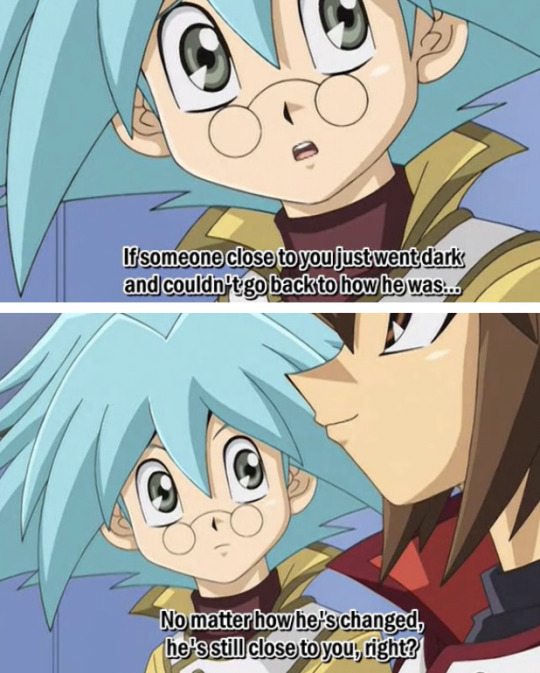
That's why if it were me. I'd probably just be looking after him until the very end, even if I didn't like him. I'd do it cause I think it'd prove that I care about him.
Judai doesn't even say that Sho is obligated to save his brother or morally redeem him, just that he has to keep looking at him instead of turning away or ignoring him.
Judai is being a bad friend, by his own definition. By choosing to deliberately look away from Yubel, Judai’s not living up to his advice for Sho for how you treat people you care about.
Which is why the resolution for Judai and Yubel’s arc is so important, because it’s done by Judai finally acknowledging Yubel’s pain, and promising to watch over them from now on, words that are followed by the action of physically fusing their souls together so they’ll never be alone again. Judai doesn’t just say pretty words about how they won’t ignore the crying child inside of Yubel, but instead he makes a sacrifice to save Yubel at risk to themselves to show their words are backed up by actions. Judai says Yubel will never be alone again, and then he commits.
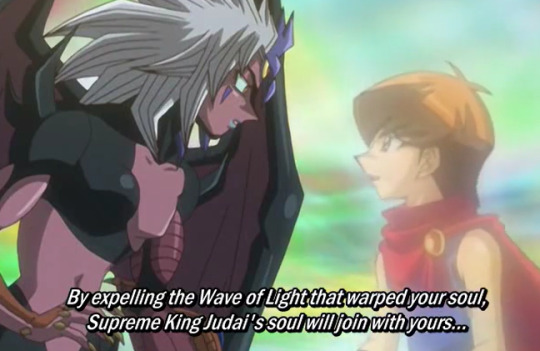
"And even if that means I won't exist anymore... I don't care."
Judai has resolved his character arc by this action, because Judai is finally taking on responsibility and that responsibility is watching over Yubel, so the two of them can atone together. Judai even says himself this isn’t an act of sacrifice on his part, but rather him finally accepting adult responsibilities.
Judai: I wouldn't sacrifice myself for you guys. I'm just going on a journey to grow from a kid into a man.
Judai needed to save Yubel to complete his character arc and grow as a person. If Judai hadn’t saved Yubel, he would have still remained an ignorant child. By learning not to turn a blind eye to Yubel’s pain, and also smacking sacrifices and physically doing something to atone for the way they ignored Yubel up until this point they’ve not only saved Yubel they’ve also done something to address their wrongs. This also continues into the fourth season where Judai’s personal growth results in him learning what kind of hero he wants to be as in Season 4 in order to atone for the spirits that Judai slaughtered, he decides to leave his friends behind and walk the earth with Yubel helping spirits and humans get along with each other. In fact Judai’s final speech as a character isn’t even about how strong he is as a hero, but how weak he is as a person.
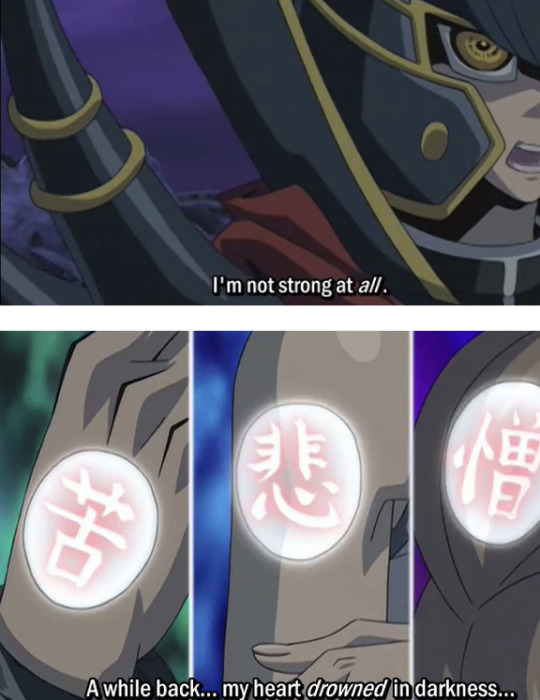
And I put my friends through some rough times. Form that, I figured a few things out... all I can do is believe in them.
The lesson Judai learned is because he’s weak, he needs to empathize and believe in other people the same way that his friends once believed in him when he was at his lowest point. Judai’s not the strongest hero, he’s the weakest one, but that gives him the ability to empathize with people who were lost just like he was, and guide them back from the darkness.
The story of how Deku became the worst hero.
I’m going to say this right now it might turn out next week that Shigaraki is just fine, and he’ll use the overhaul quirk to reconstruct his body. However, even if that happens Deku has completely failed at his goal of saving Shigaraki for the reasons I’ll illustrate below. In theory, Deku’s arc of saving Shigaraki, and therefore winning by saving should be much easier for the story to accomplish and also much less frustrating to watch. After all, Shigaraki has been around since the beginning of the manga, he’s literally the first villain that Deku faces. He’s also the first villain that Deku talks to, where he brings up the idea that there were some people All Might failed to save. There’s also many intentional parallels between the two characters, the entire manga is about their parallel journeys of becoming the next generation hero and the next generation villain. Shigaraki even directly quotes the line at one point that all he wanted was for someone in his house to tell him he could still be a hero, the same line Deku said in the first chapter was that he wanted his mom to tell him to be a hero instead of apoalogizing to him for being quirkless.
Not only is the setup for Shigaraki and Deku made obvious (Deku can redeem Shigaraki by telling him that he can still be a hero too), but Deku himself states out loud that he wants to save the crying child inside of Shigaraki.
Judai runs away from Yubel the whole time, whereas Deku is running towards Shigaraki and actively makes it his goal to understand Shigaraki and continue to see him as a human being rather than a villain. The story also makes it clear that saving Shigaraki is necessary to saving hero society as a whole. After all Yubel is just Judai’s victim. Whereas Shigaraki is the victim of all of society. He’s the crying child who was ignored. The cycle won’t be broken if heroes continue choosing to ignore people like Shigaraki, because more victims will grow up to replace him.
Shigaraki: Everything I've witnessed, this whole system you've built has always rejected me. Now I'm ready to reject it. That's why I destroy. That's why I took this power formyself? Simple enough, yeah? I don't care if you don't understand. That's what makes us heroes and villains.
Shigaraki rejects the world because the world continues to reject him. THe solution to this problem is not rejecting Shigaraki, because Shigaraki won’t go away, the system will just continue to reject people like Shigaraki. As long as heroes and villains don’t understand each other, they’ll keep being forced to fight and the conflict won’t end, because hero society is what engineers it’s own villains.
clear as day by the story itself. If the objective of saving Shigaraki is clear, then how exactly did the story fail in this objective? What went wrong? In this case it’s a failure of framing, and breaking the rules of “show don’t tell.” Stories are all about actions and consequences. When a character makes a certain action in a story, the way other characters around them, the world, and whatever consequences that action frames that action in a certain light. It provides context for how we are supposed to interpret that character in that moment.
For example, when a character does something wrong and another character directly confronts them over what they did wrong, that frames them as in the wrong. The story is criticizing the character for what they did wrong. Context is everything in a story. Stories are just ideas, so they require framing and context to communicate those ideas for the audience. Certain character attributes can be strengths or flaws depending on the context. My go to example is that if you put Othello in Hamlet, the conflict would be resolved in five seconds because Othello’s straightforward personality and determination would have him kill Hamlet’s uncle without questioning things. Whereas, Hamlet constantly questioning and second guessing himself would lead to the worst ending possible. However, if you put Hamlet in Othello, then Hamlet wouldn’t fall prey to Iago’s manipulations, because Othello doubts and questions everything so he wouldn’t believe Iago the way Othello did.
Hamlet’s contemplative and introverted nature can be a strength in one situation, and a flaw in another. Othello’s tendency to act without thinking things through can be a strength in one situation, and a flaw in another. Context matters, because context tells you how you’re supposed to interpret a certain characters actions, and therefore tells you more about that character. This is why people repeat “Show don’t tell” as the golden rule of storytelling, it’s one thing to say something about a character, it’s another to us the characters actions in the story itself to show them something about the character.
What’s even worse then breaking the rules of show don’t tell however, is telling the audience one thing, and then going onto show in the narrative something completely different. In that case the narrative becomes muddled and confusing to read. If I the narrator say “Hamlet is someone who overthinks everything” and then in the story Hamlet walks up to his uncle and kills him with no hesitation, then the narrator is straight up unreliable. It becomes impossible to tell as an author what message I’m trying to get across about these characters, because I’m telling you one thing and showing another.
This is why the writing fails in the second half of My Hero Academia because we are constantly told one thing, but then the story shows something entirely different and sometimes even contradictory to the thing we are being told.
Judai is a much worse hero than Deku, he always runs away from Yubel, and we’re never directly told that he’s supposed to save Yubel either. However, the narrative is incredibly consistent. Judai’s behavior of running away is consistent with his character. All the other character call Judai selfish for abandoning his friends (and they’re not even talking about Yubel). Judai is never painted in any positive light for his actions, therefore we as the audience understand Judai’s behavior is wrong and he needs to fix it. The narrative makes it clear that Judai needs to grow up, and Judai is never rewarded for his refusal to grow up, he’s ruthlessly chewed out, not by his enemies but also by his own friends. However, the narrative isn’t merciless on him either. Season 3 of GX is dark, but it’s not grimdark. Even when Judai loses his way, he’s still shown love and compassion by those same friends who go to great lengths for his sake. The narrative criticize Judai but it never insists that he’s beyond redemption and needs to be put down like a mad dog.
The message is very clear, that not only does Judai need to grow up, but he also deserves the chance to grow and change, which is why he should give Yubel a similar chance. In comparison the story sets out this clear narrative arc for Deku of understanding Shigaraki, but it never challenges him for failing to understand Shigaraki. If you listen to what the narrative says, how other characters describe Deku, and what Deku himself says and only read it on a surface level then yes, Deku’s goal is to save Shigaraki. If you analyze actions however, he is in effect just like Judai he never takes any meaningful action or steps towards Shigaraki, nor does he think of what saving Shigaraki might look like or entail.
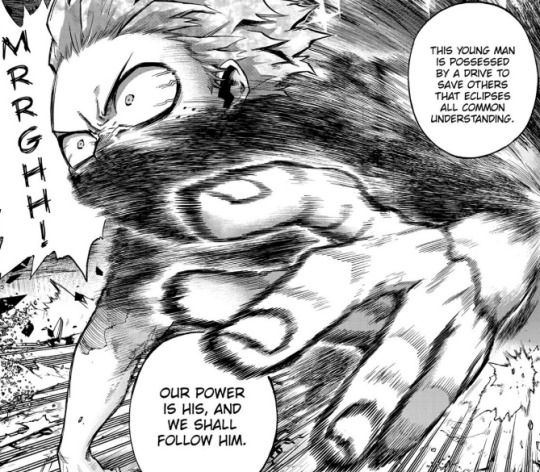
The story describes Deku as someone who is possessed by a drive to save others that eclipses all common understanding, but does the story give us any examples of that behavior?
Judai is characterized as a selfish, irresponsible child, and the story gives us countless examples of his immaturity and how it hurts others. Does the story of MHA do the same for Deku's purported virtues? Let’s run through Deku’s actions, step by step, the actions themselves and how they are framed in order to find any evidence that Deku possesses this drive to save others. Does Deku reflect at all on the question of:
Can Shigaraki be Saved?
Deku leaves on a journey to try to understand villains. When he makes a perfunctory attempt to understand and empathize with Muscle, and Muscle replies that some people are just evil does Deku keep trying to reach his heart? Nope, he just punches him.
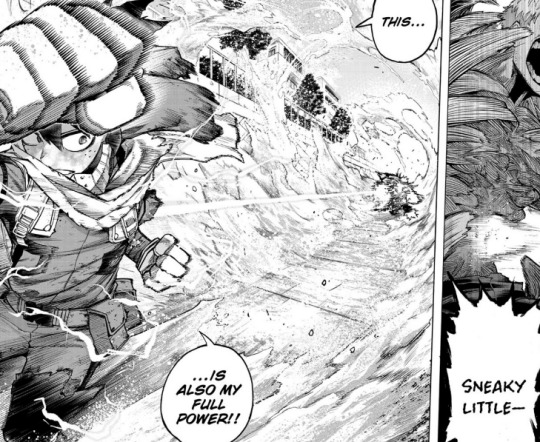
Well, if he’s failed in his goal of understanding a villain then does the story call him out on his failure? Does Deku face any sort of narrative consequence for that failure? Is he framed negatively for failing to understand Muscle, the same way that Judai is framed for abandoning Yubel? Nope. Deku doesn’t express any frustration at all over is inability to reason with Muscle. There’s also no negative consequence for Deku just choosing to punch muscle, it turns out that there was no reasoning with Muscle and some people are just bad eggs so Deku was right. It’s okay for characters to fail, but if a character fails and it’s not framed by the story as a failure then the writing itself as failed. Why even bother to include this scene in the first place if it doesn’t advance Deku’s character in any way? This scene in spite of showing Deku failing to understand someone actively paints Deku in a positive light, because of how much stronger he is ow that he can OHKO a guy that gave him trouble all the way back in the camp arc.
This scene doesn’t tell anything about Deku as a character, it just makes him look cool. In fact that’s precisely the problem, Deku isn’t adequately challenged as a character, because he’s never allowed to fail. Even when he does obviously fail at the things the narrative set out for him to do, he’s never challenged on those failures, because the priority isn’t to make Deku grow, it’s to make Deku look good. As I said before, Judai is the hero because he’s the weakest. Deku is the hero because he’s the strongest. Well, next a big flaw on Deku’s part is that he worshippd the same heroes that were making the world corrupt. Heroes like Endeavor who created people like Dabi. So, does Deku take action to either criticize the older generation of heroes, or separate himself from them in order to try to be better than them? Nope, he teams up with them. Not only that, Deku can’t do something as simple as tell Gran Torino out loud about his plans to save Shigaraki. If Deku feels that Shigaraki is worthy of salvation then he should at least try to make an argument here about his ideal of saving others.
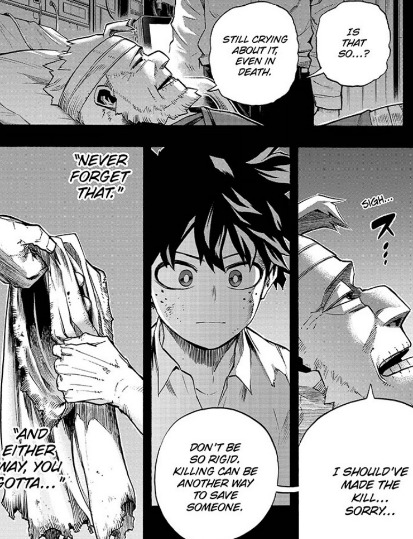
Now here’s the thing, if Deku hadn’t directly looked at the camera and told us he wanted to save Shgiaraki, would we be able to deduce his intentions from his actions? If you took away all of Deku’s internal monologue, and just showed him punching Muscular and saying nothing when Gran Torino says he may have no choice but to kill Shigaraki would anything about Deku’s actions indicate that he wants to save Shigaraki? Let me use avatar the last airbender as a positive example for a moment. People say that Aang’s desire to spare Ozai’s life comes out of left field, but like if you analyze Aang as a character down to their bending, and the way they react in situations they always prefer de-escalation, or taking a third option as opposed to confronting things head on. It’s literally why Toph says Aang has trouble learning earth bending, because as an airbender, he always tries to look for some other way to solve the problem, instead of a direct confrontation with force. As early as season one, Aang tells Zuko someone who has tried to kill him several times that he was friends with someone from the fire nation one hundred years ago and in a different situation they could be friends. Aang’s desire to save the Firelord may not have been told to us until the last possible minute, but Aang’s aversion to violence has always been a part of his character from the beginning. However, Deku never shows any similar aversion to violence. There’s basically no example where he ever tries to de-escalate a situation, or he avoids a conflict by seeking a third option.
Anyway, let’s move onto the next example. In the confrontation where Lady Nagant fights Deku, when Deku learns the fact that the heroes were employing government hitmen to attack people for uhh… exercising free speech does Deku give any reaction to this information? When Lady Nagant says that Deku is only going to bring back the status quo, does he show her any meaningful evidence that he won’t do that.
Deku’s response is because the world is so grey, he needs to extend a helping hand to others. Which you know what thay could be a response. Deku saying that his response to the corruption of the hero world is that he now understands that society led some people down the wrong path, so his way of addressing the wrongs of that society is lending a helping hand to as many people as possible even people he used to think was irredeemable.
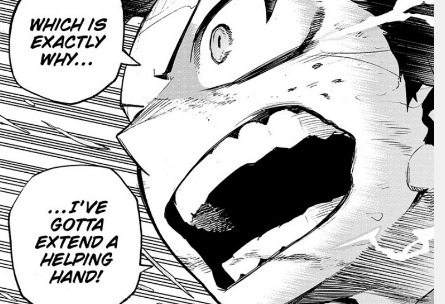
I will give Deku the benefit of the doubt, I think this is an acceptable answer. I can’t save everyone, but that’s not going to stop me from trying to save as many people as possible and maybe I can save people who were this society’s victims on the way too. However, does Deku demonstrate his resolve to extend a helping hand in any meaningful way.
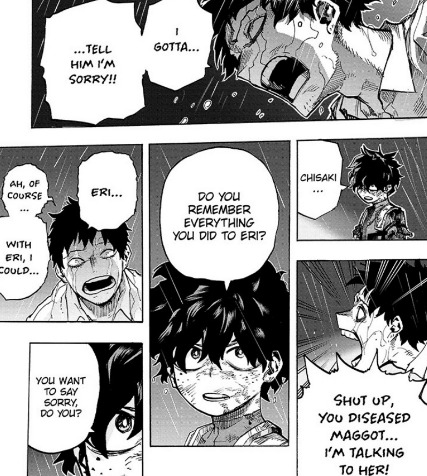
Deku is met with an armless, insane Overhaul who’s begging for someone to help heal his father figure in the Yakuza from his coma. This isn’t like Muscular who insists that there’s no helping him, Deku is met face by face with someone asking him for help. Deku’s gotta extend a helping arm whenever he can, because he knows some people were abandoned and led astray by this society… Unless that person is someone he doesn’t like personally. At which point he only helps them on a conditional basis. We are told Deku will save anyone and everyone, but Deku is met face to face with an armless man who is begging for help and Deku’s does nothing to help him. Deku’s not criticized for refusing to help overhaul either, it’s never brought up again. When Deku begins to experience a mental breakdown because of all the people he’s trying to help in the Dark Deku arc, we are told this is the result of Deku trying to save everyone, but we do not see Deku attempting to save a single villain after Muscular and Nagant.
He exhausts himself beating up villains that AFO sends after him, and only helping innocent civilians. Which would be fine if this arc were about how Deku is running away from his real responsibilities the same way that Judai was running, but that’s not what we’re being told. We are told that this is all part of an arc of Deku learning to understand villains and be a hero.
Deku is asked “Can you save Shigaraki?” by the story, but Deku never at any point has to deliberate on that question. Judai doesn’t deliberate on that question either, but him choosing not to think about things and stay ignorant is the point.
It’s actually fine to make Deku stagnate as a character. It’s fine to have him take the easy way out by just punching villains and giving up on them after one conversation. It’s fine for him to be empathetic to other people’s suffering, or even self-righteous. It’s fine for him to be ignorant.
He could be all of those things if it was a part of a narrative teaching him to unlearn his behavior. In fact the narrative might have been better if Deku started out by saying he didn’t want to save Shigaraki, that there was no choice but to kill him, because then at least his actions would be consistent with his words. Then his lack of empathy and his tendency to resort to violently beating up villains instead of avoiding violence would be character flaws he could work on. Deku however, is presented to us as this empathic hero who is always willing to give others a second chance though he never actually sticks his neck out in order to do so. Continuing on with our slow crawl through MHA, one of Deku’s friends is revealed as the traitor. Deku has a heartwarming scene fo saying that Aoyama can still be a hero, but look at his actions. He lets the adults in the room physically tie Aoyama in a straightjacket and imprison him, for the crime of… doing bad things while he was in a hostage situation. Apparently, if a bank teller helps the bank robber by giving them money when the robber has a gun to his head, the swat team should just snipe the bank teller. Not only does he not defend Aoyama against the adults, or stand up for him, or tell the adults they’re wrong to treat Aoyama a clear cut victim who had a gun to his head and was bing held hostage like he’s a villain - he also lets the adults use Aoyama an innocent victim as bait in order to lure out AFO. Deku tells Aoyama he can still be a hero, but he doesn’t defend Aoyama as a victim of being taken hostage, nor does he stop the adults from further taking advantage of him and throwing him right into danger. Some people are just led the wrong way that’s why they need to be extended a helping hand, but fuck Aoyama I guess. He needs to earn the right to be sympathized with by physically putting his life in danger.
Deku can’t even go out of his way to save a friend who he’s known for the better part of a year, when that friend is a complex victim forced to do bad things.
Then Deku and Uraraka have a conversation where they both, kind of ruminate on the idea that maybe the villains are human beings who are worthy of sympathy.
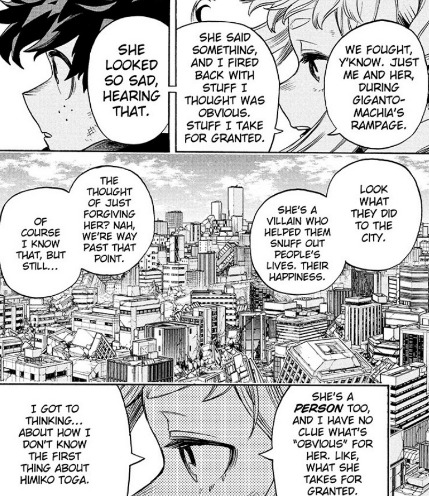
In fact Uraraka is actively trying to dehumanize Toga by looking at the destroyed city, so she won't have to think of Togaas a person.
The language here is also a major fault of this arc. It focuses far too hard on “forgiveness” over and over again. As I said before, saving Shigaraki isn’t about Shigaraki at all, it’s about Deku, and how he wants to use his power as a hero. Deku has even stated himself that he doesn’t believe that OFA is a power that should be used for killing people. So why does whether Toga or Shigaraki are forgivable or not even matter? It’s the same with Deku refusing Overhaul any sympathy. If he’s so morally opposed to abusers, then why does he work with Endeavor and defend him at every visible opportunity, even in front of his victims? Whether or not Deku can forgive Shigaraki doesn’t matter, because Deku is not the moral arbitrator or right and wrong. In fact Deku doesn’t even have any morals, so how is this a moral debate? Is there any point where Deku gives a clear definition of what he thinks right and wrong is? Does he quot Immanuel Kant to the audience?
Batman doesn’t kill people, not because he thinks that every last person on earth can be saved, but because Bruce Wayne an incredibly rich white man thinks that maybe he shouldn’t have the authority to decide who lives and who dies. When Bruce doesn’t kill the joker, it doesn’t mean he thinks the Jokers actions are forgivable, it’s because Bruce thinks it’s not his place to determine whether someone has the right to live.
The whole conflict that MHA presents us is that heroes pick and choose who to save, and only save the ones they deem as innocent. So, how does Deku saying repeatedly they can’t forgive Shigaraki contribute to that theme in any way? In fact by focusing on forgiveness, rather than whether or not he personally has the right to pick and choose who lives and who dies Deku is ignoring the elephant in the room. The question isn’t about whether Shigaraki’s redeemable or if his deeds should ever be forgiven. The question is whether Deku has the right to decide who gets saved and who doesn’t.
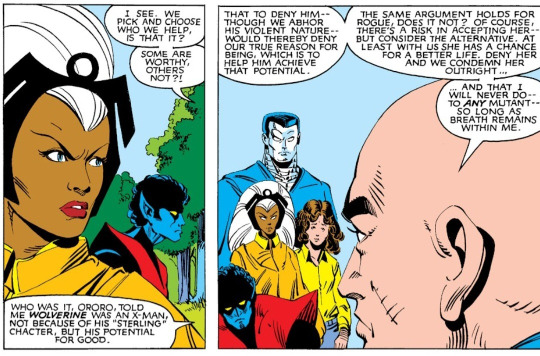
We are told that Deku as a character is someone who wants to save everyone no matter what, so Deku shouldn’t be focusing on whether or not Shigaraki is worthy of forgiveness, he should be making an idealistic argument like Xavier does in this panel. Why doesn’t Deku talk out loud with Uraraka on how he believes his power is for saving others, and not killing? If he’s meant to represent some idealistic hero, then why doesn’t he even talk about his ideals? Why don’t I as the reader know what those ideals are?
I think Xavier’s ideals of forcing the X-men to provide a good example to the mutant community, in order to try to earn the respect of other human beings is wrong, but at least he has ideals. He tries to inspire the other people around him to live up to those ideals. The story can criticize him for his ideals and point out how they’re wrong, while it can also uplift parts of his idelogy like where he believes there are no evil mutants. Deku has a chance to do the same to Uraraka, to tell her clearly, “I don’t think we as heroes have the right to pick and choose who we help…?” but he waffles. Not only does he waffle, but this moment is meant to be read as an indication that both Deku and Uraraka are sympathetic individuals who want to save their villains. They are supposed to look good and idealistic here and they don’t. For Deku it just seems like a repeat of his behavior with Overhaul. The only villains that are worthy of sympathy, are the ones that he personally decides are forgivable.
The story isn’t about whether or not it’s moral to save someone who’s killed as many as Shigaraki has. The story never seriously discusses any sort of complex morality or moral philosophy. Once again to bring up avatar, yes you can argue Aang sparing the life of a war crimminal is bad, but Aang mentions on multiple occasions that he wants to retain the cultural values of the airbending people. Aang has a morality, a consistent morality, it might not be a morality you personally agree with but at least he has one. Deku hates abusers, unless he’s next to Endeavor then he thinks abusers should be given the chance to atone. Deku doesn’t believe that One for All is a power for killing, but he never stands up to any of the adults who are blatantly trying to kill Shigaraki, he doesn’t even express out loud to Uraraka that he doesn’t think heroes have the right to decide who lives and who dies. In fact he’s given the perfect opportunity to, when Hawks kills a villain and it’s broadcast live on the news in font of everyone, but Deku never has anything to say about that. The reason Deku and Uraraka both put such an emphasis on “forgiving” their villains has nothing to do with the story itself. It’s because the author Horikoshi, is afraid that some people will misinterpret his story as saying that he actually thinks that saving a villain like Shigaraki means that he condones mass murder, so he has to have the characters talk about not forgiving Shigaraki.
Judai doesn’t have any consistent morals either, but once again that’s the point and something the story relentlessly calls him out on.
Cobra: Fortune would never smile on a fool like you who fights while prattling on about enjoying duels. Cobra: You are certainly a talented duelist. But you have one fatal flaw. Judai: A fatal flaw? Cobra: Yes, your duels are superficial. Someone who fights with nothing on his shoulders, cannot recover once he loses his enjoyment. What a duelist carries on his shoulders will become the power that supports him when he's up against the wall! Cobra: But you have nothing like that! Those who go through life without anything like that cannot possibly seize victory. Cobra: But I know that nothing I say will resonate with you... because you have nothing to lose but the match. Judai: I... Cobra: Afraid aren't you? Right now, you have nothing to support you.
Judai’s regularly called out for his superficiality. Judai is only a hero because he’s strong and wins fight, he doesn’t feel any responsibility towards other people, and in fact he loathes having to feel responsible for others. Judai isn’t just naive, he deliberately chooses to remain ignorant. Since he’s ignorant of his own faults, he makes awful decisions when it comes time for him to lead, and his friends die because of choices he made. We are told that Deku doesn’t want to remain ignorant, that he wants to understand villains, but Deku’s actual actions are him continuing to ignore society’s ills and the suffering of victims. In fact if you take away Deku’s internal monologue and the narration, Deku’s actions almost exactly mirror Judai’s.
Deku is just as superficial as Judai, and he also doesn't want to spend any time thinking about what kind of hero he wants to be, but the narrative never punishes him for it.
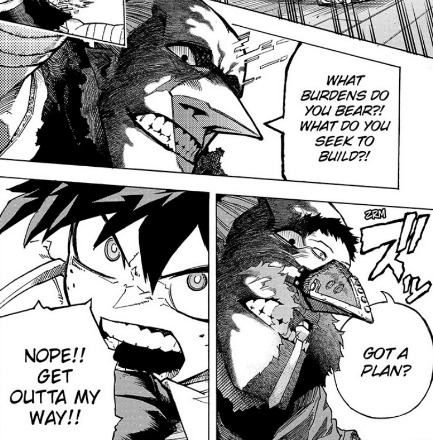
Judai is asked what burdens he has to bear and he has to meaningfull answer that question, Deku is allowed to get away with not having to think about anything. Deku remains superficial. Both Judai and Deku spend the entire arc running away from their villain rather than confronting them in any meaningful way. They both never express out loud any sympathy for their villain, or try to empathize. THey both never step down from the role of hero, and only confront their villain as a hero, because they don’t want to think about themselves as complicit or in the wrong. Shigaraki and Deku’s final confrontation mirrors Judai and Yubel’s but without the same clear framing. THe entire time Yubel is trying to get Judai to empathize with them, and Judai only responds with physical violence, because they don’t want to stop being the hero and because they can’t see Yubel as anything other than the villain. As soon as Deku arrives on the battlefield (by the way everyone else and their mom pointed this out, but Deku who doesn’t think OFA is a power for killing, is completely okay with a plan called the “Sky coffin plan” where every other hero was clearly trying to murder Shigaraki).
When Deku arrives he asks if Shigaraki is still in there, but he doesn’t do anything to try to reach Shigaraki, he jumps right to punching him. In fact he never tries anything besides punching him as hard as possible. How is punching Shigaraki with the force of a thousand suns saving him exactly? How is that different from how he tried to defeat Shigaraki the last war arc, before he saw the image of the crying child that made him want to try a different approach in saving Shigaraki? In Judai’s final fight with Yubel, it’s made explicitly clear that Judai is not trying to save Yubel, and that’s a fault on his part. In fact Judai gives the traditional “I have friends, and you don’t” speech to Yubel but it’s a subversion of how that speech is usually used. Usually that speech is used to show that the protagonist won because of they valued friendship,while the villain treated their friends poorly and only cared about power. However, it’s ironic in this case because Judai got all of his friends killed. Judai treats his friends like garbage. This speech isn’t used to show that Judai is winning because he values his friends more than Yubel does, it shows that Judai is a hypocrite, playing the hero in this situation where they are just as bad as Yubel. Judai’s not morally superior, he’s just lucky that he has good friends. Friends that were willing to save him. The only connection Yubel has to anyone else, Yubel’s only friend is Judai and Judai is a shit friend.
In fact, Mirio tries to give a version of the “You don’t have any friends” speech to Shigarkai, only for Shigaraki to get mad and tell Mirio that he does have friends and people he wants to protect.
This fact is also something that is blatantly ignored by Deku, even though Mirio tells him about it… even though we are told that Deku is trying his best to see the humanity in Shigaraki.
Judai blatantly admits they’re trying to kill Yubel. Which makes them a worse person, but a better character than Deku, because their actions are clearly framed by the narrative and consistent.
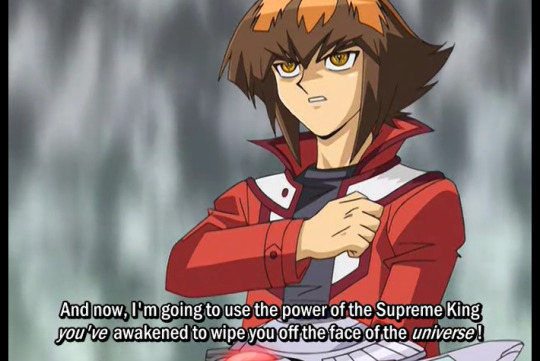
On the other hand we are told that Deku doesn’t want to kill Shigaraki, and yet everything Deku does makes it look like he’s just trying to kill Shigaraki and put him out of its misery. If we didn’t have Deku stating out loud that he wants to save Shigaraki and wants to see him as a human, there’d be nothing in his actions to indicate that he’s trying to avoid killing Shigaraki. Deku says he can’t pretend he didn’t see Shigaraki crying, but like, does he ever hesitate to punch Shigaraki, does he ever think that causing Shigaraki more harm is wrong when he’s already suffered so much? Deku says that Shigaraki is a person but does he treat him like a person? Does he try to talk to him like a person? To use avatar again, Aang does talk to Zuko pretty early on. Deku doesn’t even give the classic “We could have been friends under different circumstances” speech. When Shigaraki resists Deku’s attempts to see him as a person or emapthize with him, Deku’s response is to just resort to punching harder.
Which is in effect the same thing Judai does to Yubel, just kill them as a villain so they don’t hurt anybody else, but framed in an entirely different light. Judai is shown to be ruthless, and cold in his attempt to only settle the conflict with Yubel by violently putting them down. On the other hand we’re being told that Deku is compassionate and empathic while he punches Shigaraki with the force of a thousand suns.
There’s another eerie similarity between both of these final confrontations. At the climax of the confrontation, both Judai and Deku have a psychic vision where they see events from Yubel and Shigaraki’s childhood. This vision is supposed to help both characters understand the good in the villain they’re facing.
Let’s see the contents of this vision and how the visions change each character. Judai is shown a vision of his past life where Yubel sacrifices their entire body, and even their humanity to go through painful surgery to turn into an ugly dragon, all for the sake of protecting Judai in a previous life.
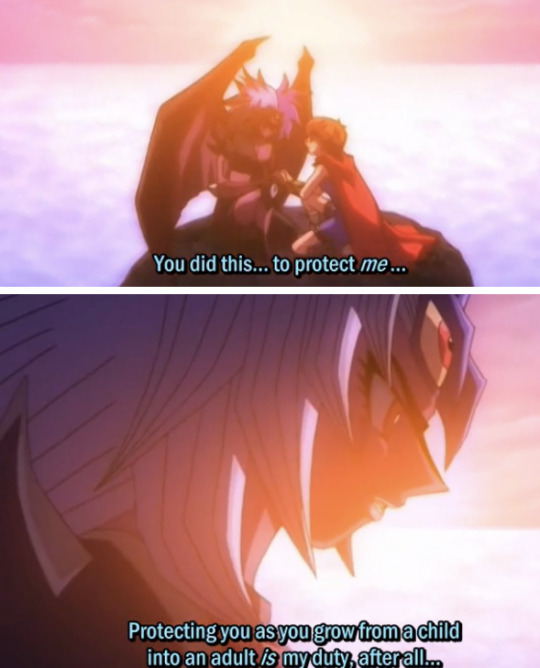
Judai is then forced to witness the good side of Yubel they’ve been ignoring all along to paint them as a villain. Yubel is simultaneously extremely selfish and willing to hurt people Judai cares about, but they’re also extremely selfless and will do anything to protect Judai and have made great sacrifices in the past for Judai’s sake. Deku gives lip service to not ignoring the humanity in Shigaraki, but Judai is literally forced to acknowledge the humanity in Yubel. Not only that, but Judai changes his behavior immediately after learning this new information. After seing the sacrifice that Yubel made for him in the past, Judai responds with a sacrifice of his own. A sacrifice that perfectly mirrors the sacrifice that Yubel once made for him. Yubel gave up their humanity for Judai, so Judai fuses his spirit to Yubel’s, becoming a human / spirit hybrid so Yubel no longer has to be alone.
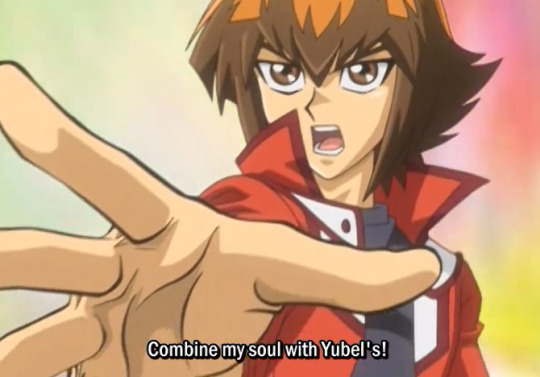
Judai also doesn’t just fuse their soul with Yubel’s in order to stop Yubel from destroying everything, it’s because both of them at this point need to atone together, and Judai is fulfilling his responsibility of watching over his friend until the end to prove that you care about them - as he said to Sho. Judai’s also fulfilling Johan’s dream of helping repair the bonds between spirits and humans, by reconciling with Yubel and repairing their bond. It’s also Judai atoning for his previous behavior of abandoning Yubel, by choosing to stay alongside them as they both atone together. Deku does sacrifice OFA during the fight against Shigaraki, but their sacrifice isn’t to help Shigaraki, but rather doing psychic damage to Shigaraki by using OFA is the only way to defeat them. He transfers OFA in order to break Shigaraki’s brain so he’ll stop reissting and Deku can beat him down. Judai fuses their soul together with Yubel out of empathy and a responsibility they feel to help their friend fater abandoning them, Deku transfers One for All to Shigaraki in order to hurt him and make him easier to punch. It's funny that Deku doesn't travel to Shigaraki's mind to learn more about him, but instead with the specific intent of harming him.
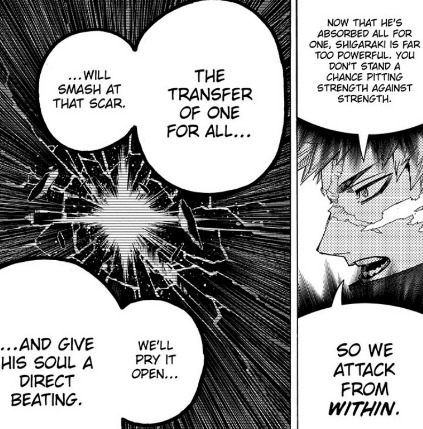
Once he's inside Shigaraki's mind, he doesn't take time to reflect on how Shigaraki used to stand up for bullied kids, or how he wants to be a hero to villains because no one else will stick up for the outcasts in society. No, he only care about Shigaraki when he takes the form of a child crying for help.
In the aftermath of the psychic vision Deku’s behavior doesn’t change towards Shigaraki in any way either. You could say he sacrificed his own arms in order to try to comfort Shigaraki within the depths of his own mind - but that’s not a real sacrifice either because his arms immediately come back. When Judai learns about the sacrifice that Yubel made in a previous life towards him, he stops seeing Yubel as an enemy and finds a way to resolve things peacefully between them. When Deku lanterns that Shigaraki’s a victim of All for One, and that his entire life was a lie, when he sees Shigaraki’s suffering first hand does his beavior twoards Shigaraki change in any way?
When he sees Afo has taken over Shigaraki’s body again, does he try to shout for Shigaraki, to tell Shigaraki to fight from the inside, to reassure Shigaraki that he’s still in there that there’s still good in him? Nope. He just punches Shigaraki some more.
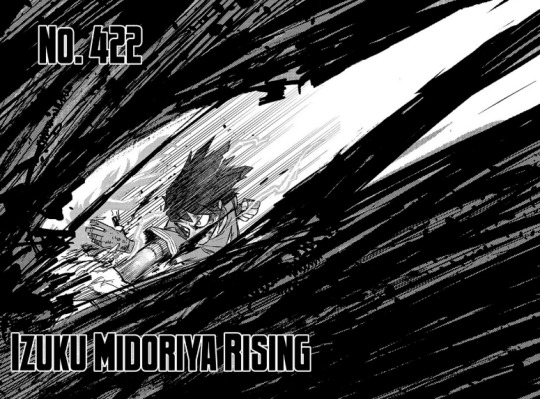
What Deku needed to tell Shigaraki is so obviously set up by the narrative too. Shigaraki wanted just one person in that house to tell him he could be a hero. Deku wanted his mother to tell him he could be a hero if he was quirkless. Deku sees that Shigaraki started out as a boy who wanted to be a hero, and who was manipulated into being a villain but does he try to appeal to the boy inside of Shigaraki by telling him he can still be a hero? Does he now see the good in Shigaraki? Nope, he just tries to kill him by punching him really hard.
I purposefully chose the images for the banner of this post, because it shows how differently MHA and GX treated its villains in the end. Yubel is embraced by Judai in the end, Shigaraki evaporates into dust.
"Judai, now that our souls have become one we will never be separated again. I have now been filled with your love and power. Let us fight together, against the wave of light leading this universe to destruction!"
Shigaraki could so easily have been given the love and empathy that Yubel was shown, but instead their life ends with no show of empathy from Deku, and with them dying believing that their long life of tragedy meant nothing in the end. Shigaraki realizes he's a crying kid, but he's never comforted.
Shigaraki: I only stole my body back from Master, and I didn't destroy anything. "In the end, I was just as you said... A crying kid, huh?"
Yubel is embraced and comforted, Shigaraki disintegrates into nothing.
One of these stories is apparently an optimistic story about heroes saving people, but it ends with the lifelong victim being killed in the most nihilistic manner possible, never receiving comfort, and never achieving anything with his long life.
The other story is a silly anime about card games, shows that when people are alone and suffering they can lash out and do terrible things. That all people are weak especially when they're alone, but the solution isn't to abandon them, or condemn them for their faults, but to believe in them and help uplift them the same way that Judai decides to uplift Yubel so they can atone together.
Which is why Deku gets an F in being a hero. Go directly to summer school. Do not pass Go. Do not collect $100.
#mha meta#ygo meta#mha 423#bnha 423#mha 423 spoilers#bnha 423 spoilers#izuku midoriya#deku#shigaraki tomura#tenko shimura#judai yuki#yubel#soulshipping#yu gi oh gx#yu gi oh
807 notes
·
View notes
Text
Last night I was talking with my friends @teefigotem and @calypsopond about the pacing of the musical Les Miserables. I think Les Mis' libretto is one of the best foundations for a musical out there, but the first act has so much more plot and more iconic songs than the second, and I worry that top-heavy structure diminishes the ultimate impact of the uprising in the second act.
Caly and Maddy agreed that the 2012 film adaption had the right idea when it swapped the positions of "Do you Hear the People Sing" and "One day More." Transplanting the former to the beginning of Act 2 maintains the balance of revolutionary fervor (and iconic songs) between the two acts, and a serves as a payoff to the tension at the end of Act 1. While "Upon these Stones/Building the Barricade" begins Act 2 in the current libretto, it's high on exposition and low on enthusiasm. Since "Do You Hear the People Sing" has become an international revolutionary anthem, making it the opening of the uprising, rather than the prelude to it, builds on *ahem* that connection.
Just picture it: the audience returns to their seats, the orchestra hums with tension, and the lights go up on a somber street with a single voice—Enjolras, probably—singing. Students emerge from the set, workers join in, the turntable starts turning and it becomes clear that soon a barricade will be built in the street. The subsequent Marius/Eponine conversation that transitions into "On my Own" would still probably work here. In the span of fifteen minutes, the thesis statement of the revolting students turns into the reveal of the final barricade. It'd be pretty damn rousing, right?
The potential problem with this change is the lacuna it would leave behind. In the current structure of Les Miserables, "Do you Hear the People Sing" is an elaboration on Enjolras' claim that "they will come when we call!" and going directly from that rallying cry to a quiet romantic interlude flattens the rhetorical tension between romantic love and revolution "Red and Black" and makes Mairus seem a little silly (which, to be fair, he is. But Enjolras is not.) Although "Do You Hear the People Sing" is a little too bombastic for Act 1, before the uprising actually begins, there's still got to be some kind of transition. Something needs to foreshadow the violence to come. But what?
I proposed that the best transition would be a reprise of Stars. And that Eponine should get to sing it.
Since the Broadway premiere of the musical Les Miserables in 1987 and especially following the 2012 film adaptation, Eponine's character has been a locus for fandom attention and discourse. Because she's really compelling: despite being the daughter of the selfish, abusive Thenardier, she devotes her life to protecting Marius and ultimately sacrifices it for him. But the closest she ever gets to being understood is by the audience; even Marius, one of two people in the show to be kind to her (the other being Valjean), doesn't really understand the full extent of her devotion to him. And that devotion is powerful, whether as a proxy for audience members' own experiences with unrequited love or a representation of the bourgeousie's reliance on unacknowleged suffering. There's a lot going on with her in the musical. But there's even more to her in the Brick.
Unlike my esteemed Les Mis mutuals I'm definitely not informed enough to do original analysis, but I'm a big fan of the Javert/Eponine wolfdog theory. My introduction to it was with this post by @pilferingapples, although I don't know whether it originated somewhere else. The theory posits that Javert and Eponine, who are both compared to wolfish dogs for their ferocity and devotion to their idiosyncratic systems of morality, are character foils who represent the limited choices offered to people excluded from. I definitely don't know the op who suggested they trade methods of death (if anyone does, please let me know!) but that's also in the Brick. And while the musical adaptation doesn't preserve Hugo's canine/lupine symbolism, it keeps Eponine's one-sided committment to guarding Marius. And it keeps Javert's devotion to the institution of Law.
"Stars" is the hymn of that devotion. It's more sinister than Eponine's love for Marius, but in the grand scheme of things it's just as pathetic. Giving a short reprise of that song to Eponine not only explicates that parallel and gives new life to relatively-unused musical motif, it has the potential to tie together the action of the first act and add a new dimension to subsequent scenes.
Imagine if, instead of beginning "Do You Hear the People Sing" immediately after "Red and Black" or transitioning directly to the Rue Plumet, the scene changes to the outside of the ABC cafe. On the other side of the turntable/wall, Eponine is waiting. And worrying. She knows her father's going to rob a house tonight and that the girl Marius asked her to find lives there*. She can't let her father hurt him. She's smarter than him. She'll do whatever it takes to keep him safe, she swears—not to God or the stars, as Javert does, but to herself. The promise is shocking, because the audience heard that melody two songs ago and are just now discovering there is another way to be. There is another vow that can be made.
While she's singing, the ABC society files out the door. Maybe some hand out pamphlets or chat with people on the street. If the production wants to emphasize Eponine and Gavroche secret sibling bond, maybe they interact a little. But no one pays her too much mind. No one ever does.
The last person to emerge is Marius, looking a bit shaken. The timeline of the students' plans has been unexpectedly accelerated, he says. In case it's his last chance—nevermind why, 'Ponine, don't worry about me—he needs to see her once. You've found her, haven't you? Could you show me? Please? For my sake?
Consumed by shame and dread and the sense that he'll probably do something really stupid if she doesn't tag along, she agrees. And the stage begins to turn into the Rue Plumet, where "In my Life" begins. The whole interaction would take maybe two minutes.
There are of course thematic objections to this plan. There's the argument that "Stars" ought to be a unique, distinct song like "Bring Him Home." But those motifs are reused in instrumental form after Javert's and the students' respective deaths, so I don't necessarily think they're scene- or character-specific. There's also the argument that the melody of "Stars" is altogether too rigid for Eponine's character. I think there are a couple moments that would work quite well with the emotion("and if they fall as Lucifer fell," for example) but if you really don't want Javert's and Eponine's motif to cross, the melody of "A Little Fall of Rain" ("and you/I will keep me/you safe") could work for this moment too.
There's also the argument that Eponine already gets "too much" attention in the musical adaptation and doesn't need. But I don't know if that's true either. She interacts with Marius in several short scenes, she's present for "A Heart Full of Love" and "One Day More," she goes on her errand to Valjean, sings "On my Own," goes back to the barricade and dies shortly after. She gets about as much stagetime as Cosette does, and a little less than Marius.
It's true that she stands out as a character, but that's because she's got such interesting writing and is so isolated in the narrative. And while it's important to keep her "on [her] own," for the plot, using shared motifs to emphasize her symbolic similarities with other characters might make her character fit more cohesively into Les Miserables' grander thematic narrative. It could even make "On my Own" that much more powerful if she has a little hope that saving Marius from her father might get him to like her, and subsequently understands that this is not happening. But there's a lot more to her than being Marius' rejected best friend** and this choice has the potential to make that clear onstage.
In conclusion: moving "Do You Hear the People Sing" to the start of Act 2 letting Eponine do a wolfdog reprise of "Stars" between "Red and Black" and "In my Life" would be sick as fuck and maybe resolve some pacing issues in the libretto.
*There is a moment in the show where she realizes that she and Cosette grew up together. I like it in concept but it's a little awkwardly-placed and integrating it into the unnamed Red and Black/In my Life transition song would be great. Overall, her interactions with Marius seem like afterthoughts in between the larger numbers, which isn't fair to either of them.
**And for the record: this not a post pitting her against Cosette! They are both good characters and I wish the best for both of them!
#ok sherb time to list everything this theory is relevant to:#les miserables#les mis#musicals#eponine#javert#marius#red and black#stars#do you hear the people sing#in my life#on my own#rhymes with thaumaturge#sherb's sub sub library
72 notes
·
View notes
Text

The Wire is an American crime drama television series created and primarily written by American author and former police reporter David Simon . . . Set and produced in Baltimore, Maryland, The Wire introduces a different institution of the city and its relationship to law enforcement in each season while retaining characters and advancing storylines from previous seasons. The five subjects are, in chronological order; the illegal drug trade, the port system, the city government and bureaucracy, education and schools, and the print news medium. . .
Simon has said that despite its framing as a crime drama, the show is "really about the American city, and about how we live together. It's about how institutions have an effect on individuals. Whether one is a cop, a longshoreman, a drug dealer, a politician, a judge or a lawyer, all are ultimately compromised and must contend with whatever institution to which they are committed."[5]
The Wire is lauded for its literary themes, its uncommonly accurate exploration of society and politics, and its realistic portrayal of urban life. During its original run, the series received only average ratings and never won any major television awards, but it is now often cited as one of the greatest shows in the history of television.[6]
. . .
Salon has described the show as novelistic in structure, with a greater depth of writing and plotting than other crime shows.[27]
Each season of The Wire consists of 10 to 13 episodes that form several multi-layered narratives. Simon chose this structure with an eye towards long story arcs that draw in viewers, resulting in a more satisfying payoff. He uses the metaphor of a visual novel in several interviews,[7][48] describing each episode as a chapter, and has also commented that this allows a fuller exploration of the show's themes in time not spent on plot development.[5]
. . .
"We are not selling hope, or audience gratification, or cheap victories with this show. The Wire is making an argument about what institutions—bureaucracies, criminal enterprises, the cultures of addiction, raw capitalism even—do to individuals. It is not designed purely as an entertainment. It is, I'm afraid, a somewhat angry show.[52]"
80 notes
·
View notes
Text
Yu-Gi-Oh! Zexal 2 - When Splitting A Season is Shilling Bad Writing All Over
Alright, so where do I even start with Yu-Gi-Oh! Zexal II? If you thought the first season of Zexal was bad, then buckle up because Zexal II takes the dumpster fire and somehow adds even more fuel to the flames. This is a perfect example of a series that just doesn’t know when to quit, dragging its feet and pretending like there’s more to say, when in reality, the story’s dead on arrival. And I can’t help but compare Zexal II to the Power Rangers Neo-Saban era—it’s a perfect analogy for how both these franchises took massive steps backward by dumbing everything down for younger audiences, with absolutely no regard for long-time fans or storytelling quality.
From the start, it’s clear that Zexal II is just riding on the same bland formula that Zexal already beat into the ground. There’s no real sense of stakes or progression, just a series of badly structured duels that feel like they’re pulled from the worst Saturday morning cartoon clichés imaginable. The show lacks any genuine creativity in its storytelling. I mean, come on—brick walls, overly complicated monster designs, and zero substance in the narrative. You’d think they’d try to evolve the series by adding some deeper themes or pushing the boundaries of what Yu-Gi-Oh! could offer, but nope, it’s more of the same childish nonsense with little thought behind it.
Let’s talk villains. Dr. Faker, at the very least, had some motivations. Sure, he’s not exactly Shakespeare, but you can kind of see where they were going with him—he wanted power to save his family or whatever, standard Yu-Gi-Oh! fare. But Don Thousand? Oh man, Don Thousand is the absolute worst. He’s literally a cookie-cutter villain ripped straight from the Showa era of tokusatsu. Think about it: he’s just this ancient evil force who shows up because… reasons. There’s nothing compelling about him at all. No real backstory, no depth, just a stock "I am evil because the plot demands it" kind of character. It’s almost laughable how one-dimensional he is. Even Zorc from the original series had more going for him than this guy, and Zorc was basically just a giant evil blob with a bad attitude. Don Thousand is the epitome of lazy writing.
Now let’s address the elephant in the room: the series was clearly aimed at a younger audience. But this isn’t just “young”—it’s aimed at really young kids with, let’s be honest, low IQs. They dumbed down everything: the dialogue, the dueling strategies, the characters. There’s no complexity here, no nuance, no challenge for the viewer. It’s spoon-feeding time, folks. It’s insulting to anyone who grew up with the original series or even 5D’s. And here’s the thing, Yu-Gi-Oh! has always been about bringing in a younger demographic, but this is the point where the series went off the rails. They didn’t trust their audience to think critically or to handle more mature themes. Compare that to the first three series, where you had actual stakes and well-rounded characters. Yuma and the gang are just a bunch of cardboard cutouts designed to sell trading cards to kids who don’t know any better.
And let’s not even talk about the duel mechanics, because they go nowhere. The whole point of Yu-Gi-Oh! used to be the creativity in how characters could use their decks and strategies. But Zexal threw that out the window, especially in Zexal II, with half the duels turning into rinse-and-repeat patterns that don’t make sense. It’s as if the writers were more interested in flashy monster animations than giving us actual tension or innovation in the duels. They’re just bad, drawn-out spectacles, filled with asspulls and nonsensical card effects. And because the story was so poorly structured, it’s hard to care when the duels have zero consequences or emotional payoff.
Now, let’s give credit where it’s due: at least 5D’s made some kind of effort to fix its second half. Yes, 5D’s stumbled with its narrative during the later arc, but at least it tried to bring the characters back into focus and repair some of the mess it created. Zexal II? It just doubled down on all the worst aspects of the first Zexal series. And the pacing was atrocious. It dragged, and dragged, and dragged, until you were begging for the end credits. The series had no business even thinking about setting up a Zexal III, but they dropped hints for it anyway. Why? Who knows? Maybe they thought they could milk this disaster for another season, but the fanbase wasn’t having it.
And that brings us to the fandom, or at least the portion of the fandom that gatekeeps Zexal like it’s some misunderstood masterpiece. They’re quick to defend the show’s "heartwarming" themes and brush off all the legitimate criticisms as people "not getting it." No, it’s not that we don’t get it; it’s that there’s nothing to get. The show is shallow. The characters are hollow. The writing is subpar. Yet, somehow, it’s propped up by this small but loud corner of the fandom who refuse to admit that Zexal was a serious misstep for the franchise. They even point to its inflated ratings as some kind of proof that it’s good, but that just shows how broken the system is when it comes to assessing quality. It's like they’re watching a different show than the rest of us.
You know what’s ironic? Yu-Gi-Oh! VRAINS feels more like a Yu-Gi-Oh! series than Zexal ever did. VRAINS at least attempts to return to the roots of the franchise, with darker themes, characters that grow, and duels that require actual strategy. It's not perfect, but it’s way more in line with what fans of the original series expect from the franchise. Zexal doesn’t even come close. It’s not Yu-Gi-Oh!—it’s a Saturday morning cartoon nightmare that’s been turned into a hollow shell of its former self.
In conclusion, Yu-Gi-Oh! Zexal was the franchise’s identity crisis put on full display, and Zexal II only made things worse. It dumbed down everything for a younger audience that was clearly seen as too immature to handle anything more than the most basic storytelling. The duels were bad, the villains were lazy, and the show overstayed its welcome. It’s an era of the franchise that’s best forgotten, and anyone trying to defend it is either blinded by nostalgia or refuses to acknowledge the very obvious flaws. The only thing Zexal did was set the bar so low that almost anything that came after felt like a step in the right direction.
2 notes
·
View notes
Text
Card Showcase: Mage Armor
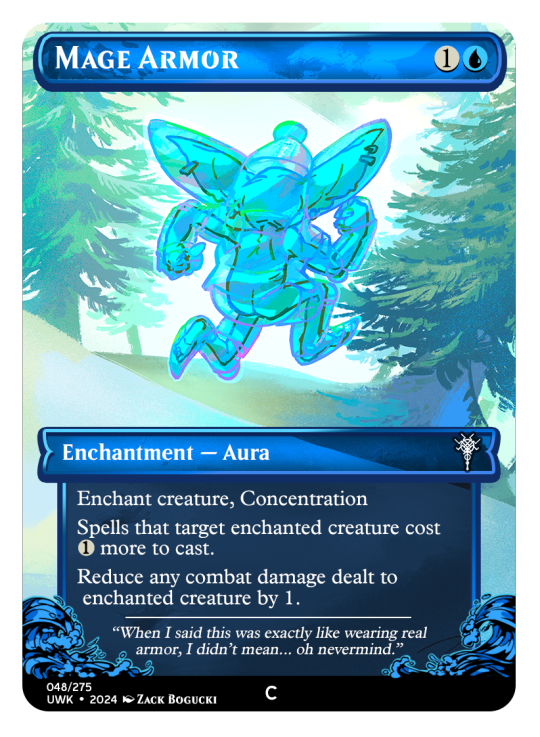
Enchantment — Aura 048/275 Uncommon
Enchant creature, Concentration (If enchanted creature is dealt damage or targeted by a spell or ability, sacrifice this enchantment.) Spells that target enchanted creature cost 1 more to cast. Reduce any combat damage dealt to enchanted creature by 1.
Creating Concentration, one of this set's unique mechanics, opened up a brand new pocket of design space to explore. The flavor was there — like many spells in D&D, they should have some persistent effect until the caster's concentration is broken!
But there were still questions to answer. How should these feel different from an average Aura? How to mitigate the "feels-bad" scenarios where an opponent breaks Concentration immediately? What sorts of effects reward players for protecting their enchanted creatures over multiple turns? What effects might each color have to use this mechanic differently?
Mage Armor was one of the first of these spells designed, and it serves as a baseline. The effect is pretty tame compared to other, flashier options in the set, but it trades a scaling payoff for a solid, persistent layer of protection that makes it harder for opponents to break. This is a good option in blue to protect an under-statted Wizard or make any creature dominate combat against 1-power tokens and early game enemies!
Originally, this card gave Ward 1 instead of the wordier "Spells that target enchanted creature cost 1 more to cast," until I realized during a playtest that Ward is structured in an inconvenient way. Technically, players could still target the enchanted creature without paying the Ward cost. Their spell would be countered, but the creature would already have been targeted, breaking Concentration! Magic is a silly game.
2 notes
·
View notes
Text
Learn Futures with ICFM Derivatives Trading Course Now

In the fast-paced world of financial markets, derivatives play a crucial role in hedging, speculation, and risk management. For anyone serious about entering the world of futures, options, and advanced market instruments, enrolling in a Derivatives Trading Course is essential. It’s not just about learning theory—it’s about mastering strategies that impact real-time trading decisions.
ICFM INDIA is the only financial institute in India offering a comprehensive, industry-aligned Derivatives Trading Course designed to prepare learners for both professional trading careers and individual investing. Whether you're a student, working professional, or finance enthusiast, this course gives you the tools and insights to operate confidently in the derivatives segment.
Why the Derivatives Trading Course is a Must in Today’s Financial Environment
Derivatives are contracts that derive their value from underlying assets like stocks, indices, commodities, currencies, or interest rates. These instruments allow traders to hedge risks, speculate on market movements, and manage exposure. In today's volatile global market, understanding derivatives is no longer optional—it’s a necessity.
That’s where the Derivatives Trading Course from ICFM INDIA becomes vital. The course covers everything from the basics of derivative instruments to advanced trading strategies involving futures, options, and swaps. With increasing participation in the derivatives market in India, having certified knowledge in this domain greatly boosts your financial IQ and career opportunities.
ICFM INDIA Is the Only Institute Offering the Derivatives Trading Course with Real Market Exposure
Many institutions offer superficial introductions to derivative instruments, but ICFM INDIA is the only organization that offers a Derivatives Trading Course grounded in live market training, current exchange mechanisms, and trading simulations.
From understanding SEBI regulations to decoding NSE derivative products, ICFM INDIA’s course provides full-circle education. The teaching process combines real-time data, interactive analysis, and practical decision-making scenarios to prepare you for the challenges and volatility of the real market.
What sets ICFM INDIA apart is its live trading labs, allowing students to practice futures and options trading in a risk-free but realistic environment.
Curriculum Structure of the Derivatives Trading Course
The structure of the Derivatives Trading Course is curated to ensure clarity, comprehension, and confidence. ICFM INDIA delivers the course in layers—from fundamentals to strategic implementation—giving students time to absorb concepts and build skill gradually.
The modules include:
Introduction to derivatives and their significance in the market
Futures contracts: pricing, margin systems, trading strategies
Options contracts: types, greeks, strategies, payoff charts
Hedging, arbitrage, and speculation use cases
Exchange-traded and OTC derivatives comparison
Risk and capital management with derivatives
Regulatory frameworks and compliance in India
Each section is backed with case studies, real-market charts, and Q&A sessions that solidify the application of theoretical knowledge.
Who Should Enroll in the Derivatives Trading Course at ICFM INDIA?
The Derivatives Trading Course by ICFM INDIA is designed for a wide audience. Whether you are:
A student pursuing finance or economics
A trader aiming to expand into options and futures
A corporate professional handling risk management
An investor wanting to hedge your long-term equity investments
...this course is ideal for you. Even those with minimal background in finance can begin the course, as the initial modules provide a solid foundation. The course starts from scratch, but builds up to advanced concepts that give every learner an edge in the market.
Faculty with Market Expertise Delivering the Derivatives Trading Course
The instructors at ICFM INDIA are active market practitioners, not just educators. This makes a huge difference. The Derivatives Trading Course is taught by professionals who have executed derivative trades in real-time markets and managed portfolios worth crores.
They offer insights into how actual traders approach options and futures—not just from textbooks, but from floor experience. These instructors guide students through real-world simulations, risk planning, and strategy optimization—making the learning impactful and relevant.
Hands-On Practice and Simulated Trading Environment
A core benefit of ICFM INDIA’s Derivatives Trading Course is hands-on exposure. Students not only learn theoretical concepts but actively engage in mock trading environments. This includes:
Simulated futures and options positions
Live chart analysis
Trading using option chains and payoff diagrams
Adjusting trades in volatile market conditions
Such exposure makes students comfortable with real-time decisions. They gain the ability to read market signals, execute trades confidently, and manage losses and profits strategically—an essential ability for long-term success in derivative trading.
Placement Support and Certification After the Derivatives Trading Course
One of the biggest advantages of choosing ICFM INDIA is career support. After completing the Derivatives Trading Course, students receive a recognized certificate that holds value in brokerage houses, trading desks, mutual fund houses, and financial firms.
Many ICFM INDIA graduates secure roles as:
Derivatives Analysts
Options Traders
Risk Management Officers
Financial Strategists
Research Analysts
The placement cell works with top financial companies to ensure learners get interviews, internships, and even full-time opportunities. Additionally, those looking to trade independently gain the skills to succeed in self-managed portfolios.
Flexibility in Learning: Online and Offline Options Available
Understanding the needs of working professionals and students, ICFM INDIA offers both offline classroom training and online virtual classes. You can choose weekday or weekend batches, with complete access to study material, recorded sessions, and interactive forums.
The Derivatives Trading Course maintains the same quality across both formats, ensuring every learner benefits regardless of schedule or location. The digital learning tools used by ICFM INDIA are advanced, user-friendly, and result-oriented.
Affordable Pricing with High Return on Investment
While most courses in the financial domain are expensive and inaccessible, ICFM INDIA has made the Derivatives Trading Course affordable to all learners. The institute believes in inclusive education and has structured the course fee to suit students and working professionals.
With high employability, self-trading potential, and income-generating strategies taught in this course, the return on investment is significant. Also, EMI plans and seasonal discounts make the course even more reachable.
ICFM INDIA’s Legacy in Stock Market Education
ICFM INDIA is a trusted name in stock market education with thousands of successful alumni. Known for its practical approach, updated content, and job-ready programs, the institute continues to lead in areas like equity trading, technical analysis, and now, derivatives trading.
With decades of experience and partnerships with market professionals, ICFM INDIA ensures that its Derivatives Trading Course remains top-tier and relevant.
Conclusion: Derivatives Trading Course by ICFM INDIA Is the Key to Modern Market Mastery
Derivatives Trading Course
As markets continue to evolve, so do the tools and techniques used to navigate them. Derivatives are complex, but with the right education, they offer some of the most powerful ways to manage risk and amplify profit.
If you're ready to take control of your trading journey or want to pursue a dynamic finance career, the Derivatives Trading Course by ICFM INDIA is your ultimate destination. Backed by real-time training, expert guidance, and industry recognition, it opens doors to limitless possibilities in the world of finance.
Read More Blogs -https://www.openpr.com/news/4061256/boost-confidence-with-this-powerful-stock-market-course
0 notes
Text
Reliable Commercial Roofing Built to Last for Every Project Need
Commercial roofing decisions often outlast business cycles, making precision and durability essential. Materials, design, and installation standards must align with energy performance, weather resistance, and structural demands. Whether managing retail complexes or industrial sites, decision-makers seek more than temporary fixes—they need systems engineered for longevity. Roofing partners with over 50 years of experience bring confidence to projects requiring detailed assessments, lifecycle planning, and tailored recommendations. Addressing small issues before they escalate is the difference between manageable maintenance and full-scale disruption down the line.

Expertise in Preventative Maintenance and Leak Solutions
Unexpected leaks or ponding water shouldn’t bring daily operations to a halt. Businesses facing membrane wear, punctures, or drainage issues often require commercial flat roof repairs that address root causes, not just symptoms. Technical evaluations focus on flashing integrity, insulation performance, and moisture detection, ensuring water intrusion doesn’t compromise internal assets or safety. Timely response combined with warranties on both labor and materials gives property managers peace of mind—knowing every square foot is protected through all seasons, not just patched for the moment.
Custom Repair Strategies for Each Roof Type
No two commercial buildings demand the same repair tactics. Multi-level roofing systems, older substrate layers, or previous work completed without clear documentation often require forensic inspection. For commercial flat roof repairs, thermoplastic weld re-sealing, elastomeric coatings, or tapered insulation retrofits are among the solutions tailored to prolong the system’s life. Businesses benefit from transparent recommendations based on specific site conditions rather than blanket approaches. Aligning the fix with both building usage and plans keeps budgets focused where they matter—on extending value, not replacing prematurely.
The Precision Behind Every Installation Project
Installing a new commercial roof is a multi-phase process where every detail—from vapor barriers to drainage angles—affects long-term performance. This level of planning suits developers, general contractors, and owners seeking systems that meet code, improve energy efficiency and hold up to variable Colorado climates. Coordination with other trades is vital to avoid rework or schedule clashes. Materials like TPO, EPDM, modified bitumen, or standing seam metal are chosen based on exposure, pitch, and occupancy needs. Professionalism and clear communication shape the outcome just as much as the materials themselves.
Why Installation Timing and Sequencing Matter
Project sequencing determines whether operations continue uninterrupted or face delays. With commercial roof installation services, the stakes go beyond rooflines—they impact HVAC placement, solar readiness, and long-term maintenance access. Working with experienced contractors ensures staging and workflow and minimizes site disruption while maintaining high safety standards. Phased delivery also allows for seasonal scheduling flexibility, ensuring that adhesives and membranes cure under ideal conditions. These small planning decisions define a project’s success months or years down the road, particularly in large-scale or phased developments.

Sustainable Roofing Systems with Long-Term Payoff
Green roofing goals, insulation values, and reflective surfaces all influence product selection for commercial roof installation services. Organizations looking to decrease HVAC loads or qualify for energy credits choose high-performing assemblies tailored to regional requirements. Metal and thermoplastic systems are usually favored for their durability, recyclable content, and low maintenance. Architects and sustainability officers benefit from material transparency, performance testing data, and projected lifecycle costs—all critical when roofing impacts everything from comfort to insurance rates. Systems backed by lifetime warranties validate that commitment to quality over compromise.
Support for Insurance Claims and Emergency Response
After a storm, time becomes a factor. Delays in damage assessment or temporary protection can result in escalated losses. Insurance clients require not just rapid commercial flat roof repairs, but documentation and guidance on navigating complex claims processes. Photographic evidence, drone inspections, and professional reports all contribute to strong claim submissions. In emergency contexts, stabilization comes first—tarps, sealing, and moisture containment—followed by strategic restoration. Partnering with providers who understand adjuster expectations and code requirements ensures smoother settlements and faster returns to normal operations.
Tailored Solutions for High-End and Custom Builds
Unusual architectural demands, from barrel lockers to mixed-material transitions, demand roofing expertise beyond off-the-shelf outcomes. Builders and property owners opting for custom-fabricated parts, like copper detailing or hand-laid slate, require craftsmanship that aligns aesthetics with longevity. These projects often blend artistry with engineering precision. Details like soldered seams, concealed fasteners, and color-matched flashing speak to elevated expectations. For such clients, commercial roof installation services are about more than function—they’re about preserving vision, enhancing property value, and standing out in both skyline and structural integrity.
Conclusion
A well-built commercial roof does more than protect—it elevates the entire structure’s resilience, value, and functionality. Whether resolving storm damage, expanding facilities, or designing standout structures, professional service remains non-negotiable. Mid-project clarity, warranties that mean something, and a clear roadmap from start to finish—these are the hallmarks clients deserve. With over five decades of industry experience, solutions remain grounded in performance, not promises. For more on dependable installation and expert repair strategies, visit Weroof.com, where informed guidance and dependable service meet every kind of roofing need across Colorado.
Visit Us :-
https://weroof00.blogspot.com/2025/06/reliable-commercial-roofing-built-to_01956016540.html
0 notes
Text
Expert-Led Options Trading Course

ICFM (Institute of Career in Financial Market) offers a comprehensive options trading course designed to transform beginners into confident derivatives traders. This specialized program dives deep into the world of calls, puts, spreads, and straddles, teaching students how to leverage these instruments for strategic advantage. The curriculum covers everything from basic terminology to advanced Greeks (Delta, Gamma, Theta, Vega), empowering traders to navigate volatile markets with precision.
What sets ICFM's options trading course apart is its hands-on approach. Participants engage in live market simulations, learning to construct iron condors, butterflies, and other complex strategies under expert guidance. The institute emphasizes practical risk management techniques specific to options, teaching students to calculate payoff diagrams and assess probability distributions before entering trades.
ICFM's faculty comprises seasoned options traders who share real-world insights about volatility trading, premium decay, and position sizing. The course demystifies concepts like implied volatility skew and exotic options, preparing students for both retail trading and professional market-making roles. Special modules cover index options, commodity options, and the unique aspects of weekly/ monthly expiry cycles in Indian markets.
Beyond strategy building, the program trains students in options analytics software and back-testing techniques. ICFM's alumni success stories demonstrate how this options trading course helps participants transition from speculative trading to consistent income generation through premium selling strategies. The institute's certification adds credibility for those pursuing careers in hedge funds or proprietary trading desks.
With flexible learning formats available, ICFM makes sophisticated options education accessible to working professionals. Whether aiming to hedge portfolios or trade volatility professionally, this course provides the structured learning path missing from most self-taught approaches to options trading.
0 notes
Text
Why Fire Protection BIM modeling in Texas is Essential for Modern AEC Projects
In Texas, where cities like Austin, Dallas, and Houston are expanding rapidly, construction projects are getting more complex and safety systems like fire protection need to keep up. That’s where Fire Protection BIM (Building Information Modeling) comes in. It’s not just a digital trend it’s becoming an industry essential.
Let’s explore why Fire Protection BIM Modeling is reshaping how buildings are designed, approved, and built across the Lone Star State.
What Is Fire Protection BIM?
Fire Protection BIM Modeling is the process of designing fire suppression and detection systems (like sprinklers, standpipes, alarms, and hydrants) in a 3D environment. But this isn’t just about visuals it’s about data-rich modeling. Every component includes technical specs, codes, and performance metrics.
Think of it as a digital twin of your building’s life safety systems, designed for coordination and compliance from the ground up.
Why It Matters in Texas
Texas construction is fast-paced and spread across diverse terrain from hospitals in Dallas to industrial plants in Houston. Managing fire protection on large-scale projects without digital coordination often leads to clashes, delays, and rework.
With BIM, you can:
Spot clashes early between fire systems and other trades (like HVAC or structural beams)
Produce more accurate estimates and fewer change orders
Coordinate with architects, contractors, and inspectors from a single model
In a state where labor costs and timelines are under constant pressure, BIM streamlines the entire design-to-installation workflow.
Regulatory Benefits
Texas cities enforce NFPA standards along with their own codes. BIM helps fire protection engineers stay compliant by embedding those requirements into the design itself.
Fire marshals in cities like San Antonio and Fort Worth increasingly review digital BIM files during plan approval. With models showing clearances, zone drawings, and access points, inspectors get the full picture faster.
For contractors, that means fewer rejected submittals and more predictable inspection outcomes.
How Contractors and Engineers Benefit
BIM isn’t just for architects. For fire protection contractors and MEP firms, the payoff is tangible:
You get fabrication-ready drawings straight from the model
Fewer delays during install due to clearer routing and layout
Models double as as-builts for owners or facility managers
And as clients start asking for digital twins for future maintenance, having a well-structured BIM model gives you a long-term edge.
Real Example: Healthcare in Austin
On a recent hospital project in Austin, BIM helped fire protection engineers coordinate with HVAC, electrical, and medical gas systems across multiple wings. The model flagged over 20 clashes early in design saving thousands in field changes.
BIM also allowed the team to simulate alarm coverage, ensuring compliance and smoother reviews.
Trust the Experts at Clove Technologies
As BIM adoption grows in Texas, so does the need for experienced partners who understand the tools, the codes, and the construction landscape.
Clove Technologies offers specialized Fire Protection BIM Modeling services tailored to Texas regulations and project demands. Whether you’re designing a high-rise in Dallas or a logistics hub near Laredo, Clove’s BIM team brings precision, coordination, and code compliance to every project.
If you’re looking to reduce rework, speed up inspections, and build safer structures, now’s the time to explore how Clove Technologies can support your fire protection strategy.
Check out this blog on Electrical BIM Modeling in USA.
Keywords : Plumbing BIM modeling, Mechanical BIM modeling in Texas, Fire Protection BIM modeling in Texas, Fire Protection BIM modeling in Texas, Low Voltage BIM modeling in Florida, Plumbing BIM modeling in Georgia, Mechanical BIM modeling in Illinois, Fire Protection BIM modeling in Illinois, Electrical BIM modeling California, Low Voltage BIM modeling, CaliforniaBIM modeling in Georgia, Scan to BIM, Scan to BIM in Georgia, H.V.A.C 3D Modeling in US / USA, Plumbing 3D Modeling, H.V.A.C 3D Modeling.
0 notes
Link
[ad_1] As the US and China escalate their trade war through tit-for-tat tariffs, it is tempting to view the situation as irrational brinkmanship.However, beneath the surface, the pattern follows a familiar structure in economics, specifically the “Prisoner’s Dilemma” in game theory — albeit one complicated by geopolitics, national pride and the realities of domestic politics.In the traditional Prisoner’s Dilemma, two players (in this case, the US and China) each have two choices: cooperate (lower tariffs, open trade) or defect (raise tariffs, restrict trade). The payoffs are clear:If both cooperate, both benefit and no one “loses face.” If one defects while the other cooperates, the defector wins big, gaining market share and strategic advantage, while the cooperator looks weak and loses economically and politically. If both defect, both suffer — but at least neither “loses face” to the other.Graphic: Author suppliedIn purely economic terms, mutual cooperation would clearly be the most optimal outcome. Yet in this case, losing face carries heavier consequences.For Beijing, being perceived as capitulating to American pressure would not only undermine its international credibility but would also affect its political strength domestically.For Washington, especially under an administration defined by its transactional style, appearing “tough on China” remains a major electoral asset.Trust, time and TrumpTwo additional dynamics make this particular iteration of the Prisoner’s Dilemma much more complex.First, trust is at an all-time low. President Trump’s well-known capriciousness leaves counterparties understandably skeptical of any promises. Deals can be reversed, tariffs can be raised and imposed without warning and the political logic often shifts depending on domestic electoral swings and business lobby desires.Second, this is not a repeated game, at least from China’s perspective. In game theory, repeated interactions encourage cooperation because each side knows it must live with the consequences over multiple rounds.Here, China knows it might only need to weather one term or possibly just another year of Trump’s administration. With US midterms on the horizon, there is little incentive for Trump to make serious concessions now.When the game is short-term, the safest move becomes defecting, regardless of the broader economic cost. Vietnam offers a sobering illustration of what happens when a player tries to cooperate too early. When Vietnam floated a plan to eliminate tariffs on US goods in the hope of reciprocal treatment from the Trump administration, rather than rewarding the offer, US officials flatly rejected it, criticizing Vietnam’s trade surplus and accusing it of “dumping” cheap products such as shrimp into the American market.The lesson for China was obvious – caving early does not guarantee leniency. Indeed, it may simply invite more demands.More than just tradeThe consequences of the mutual defection extend far beyond the tariffs themselves. Global supply chains continue to shift – companies are accelerating efforts to diversify away from US-centric or China-centric models.Instead, they are investing across Southeast Asia, Latin America and even Africa, viewing them as potential final demand destinations and not just as offshore manufacturing bases. Intra-Asian trade is strengthening as countries seek alternatives in a polarized global order.Meanwhile, the political framing, particularly in the US, has become increasingly zero-sum: if China benefits, America must be losing. This leaves little room for the nuance and compromise that international trade agreements typically require.As a result, the tariff war is no longer just an economic dispute. It is a contest over narrative, pride and geopolitical influence.No easy exitIn an ideal world, both sides would recognize the mutual damage and seek a face-saving solution.But with trust eroded, incentives misaligned and the political cost of losing face ever so high, mutual defection has become the Nash Equilibrium. Neither side wants to back down and both would rather lose economically than appear weak.The real tragedy isn’t just in the tariffs themselves. It is in how deeply trust has broken down, making cooperation harder not only today, but well into the future. Still, two broad paths remain for breaking the destructive cycle – changing the payoffs and finding a face-saving exit. The first is if defection becomes much more painful than cooperation. This could happen if the domestic costs of the tariff war – slower growth, inflation, declining exports and a louder backlash from affected industries – begin to outweigh the political gains of “looking tough.”The second path is more psychological but no less important. Given the strongman personas of both Trump and Xi, neither is likely to back down unless there is a narrative that allows them to do so without losing face.This might come in the form of a temporary truce framed as “strategic recalibration” or even cooperation on a larger crisis that redirects attention and justifies de-escalation. In short, what’s needed is not just a better deal, but a better story – one that allows both sides to retreat gracefully without looking like they’ve surrendered. [ad_2] Source link
0 notes
Text
TECHNICAL REPORT Federal Reserve Board – Office of Systemic Risk Analysis Subject: Strategic Implications of Public Communications by Goldman Sachs CEO David Solomon Date: April 2025 Prepared by: Renato Ferreira da Silva
I. Executive Summary
David Solomon, CEO of Goldman Sachs, has publicly adopted a dual-pronged communication strategy: combining optimistic projections for corporate finance (notably M&A recovery) with warnings about macroeconomic risks linked to U.S. trade policy. This paradox—public risk signaling coupled with record trading profits—warrants strategic attention by the Federal Reserve. Solomon’s statements function not merely as commentary but as potential influence levers for monetary policy and regulatory posture.
II. Observed Narrative from Solomon (April 2025 Earnings Call and Media Interventions)
Describes the M&A pipeline as "historically strong" for H2 2025.
Simultaneously warns of "material risk" to global economic stability stemming from tariff-driven uncertainty.
Affirms that Goldman Sachs clients (CEOs, institutional investors) are hesitant to make long-term commitments.
Attributes Q1 profit boost (+15% YoY) primarily to equity and FICC trading, linked to volatility.
III. Strategic Analysis – Game Theory Perspective
Game Structure:
Players: Goldman Sachs, Federal Reserve, Global Investors, Corporate Clients.
Actions: Signal risk (to justify cautious Fed policy); profit from volatility; maintain institutional trust.
Equilibrium Type: Nash equilibrium under incomplete information with asymmetric signaling.
Solomon’s Payoff Structure:
Short-term: High trading revenue via volatility.
Medium-term: Influencing the Fed toward rate accommodation, increasing asset prices.
Long-term: Positioning Goldman as a stability partner and global financial intermediary.
Risks to the Fed:
Mistaking risk communication as neutral rather than interest-driven.
Premature rate cuts feeding asset inflation and speculation.
Erosion of Fed credibility if perceived as reactive to market-originated narratives.
IV. Policy Implications for the Fed
Option 1 – Preventive Accommodation:
Pro: Aligns with market pricing; supports liquidity.
Con: Reinforces private incentive structures that benefit from instability.
Option 2 – Strategic Forward Guidance with Conditionality:
Pro: Preserves flexibility; tempers market overreaction.
Con: Requires clear calibration to avoid misinterpretation.
Option 3 – Regulatory Offset:
Pro: Limits excessive trading leverage.
Con: Potential backlash from large institutions.
Recommended Path: Combine Option 2 and 3.
Deploy a forward guidance strategy that distinguishes between inflation-driven vs. uncertainty-driven easing conditions.
Initiate interagency review of systemic leverage exposure to volatility trading.
V. International Dimensions
U.S. tariff policy escalations have triggered volatility in EM FX and global commodities.
Coordinated communication with ECB, BoE, and BoJ could preempt destabilizing capital flows.
Consider reactivating bilateral swap lines with selected EM central banks as a containment mechanism.
VI. Strategic Monitoring Recommendations
Establish dedicated alert tracking for Goldman Sachs public communications.
Cross-reference trading desk performance with timing of public statements.
Incorporate large-bank signaling into quarterly systemic stress-testing scenarios.
VII. Conclusion
The strategic ambiguity deployed by Goldman Sachs and David Solomon introduces a narrative environment favorable to market instability-driven profitability. The Federal Reserve must interpret such communications through the lens of strategic self-interest. A combination of disciplined forward guidance and calibrated macroprudential measures is advised to safeguard institutional independence and system-wide resilience.
Distribution: Restricted to senior Fed officials, FOMC policy staff, and Systemic Risk Coordination Council.
0 notes
Text
How This One Marketing Trick Took a Crypto Project from Zero to $10M!
In the lightning-speed world of crypto, attention is everything. With thousands of tokens launching and vanishing each year, gaining visibility can feel like screaming into the void. But every once in a while, a project emerges from the shadows and captures lightning in a bottle—growing from obscurity to multi-million-dollar success seemingly overnight. That’s exactly what happened to one underdog crypto project, and the secret behind its meteoric rise? One brilliantly executed marketing move: The Viral Loop Airdrop.
Let’s break down how this one tactic transformed a ghost-town project into a $10 million phenomenon—and how you can use it to power your own crypto growth.
From Unknown to Unstoppable: The Origin Story
Like many crypto startups, the team behind this DeFi project began with little more than code, conviction, and a whitepaper. They weren’t influencers. They didn’t have institutional funding. In fact, for the first few weeks post-launch, their metrics were dismal: a few dozen Twitter followers, an empty Telegram channel, and almost zero website traffic.
They tried AMAs, joined Twitter Spaces, even cold-DM'd influencers. Still—crickets. It became clear: the old playbook wasn’t working. If they were going to survive, they needed something radical. Something viral.
The Breakthrough: Building a Viral Growth Engine
After studying growth hacks from both Web2 startups and successful Web3 communities, the team landed on a concept known as the viral loop. Unlike a standard airdrop—which gives tokens to early users with no further engagement—this strategy created an incentivized sharing ecosystem.
In simple terms, users earned tokens not just for signing up, but for bringing in friends, and even more if those friends invited others. It created a chain reaction. The more someone contributed to the project’s growth, the more they were rewarded. It flipped passive users into active marketers.
How They Built It: The Viral Loop Airdrop Structure
First, they launched a pre-token signup page, complete with wallet and email capture. Once registered, users received a unique referral link. Every time a new person joined through their link, they earned points—visible on a live leaderboard. Hitting certain thresholds unlocked increasing tiers of rewards.
This wasn’t just about free tokens. It was about gamification. Users competed for top spots, racing to unlock exclusive NFT badges, early staking access, and larger token allocations. Leaderboards were updated in real time. People bragged about their rank on Twitter. Some even ran paid ads to boost their own referrals.
Making It Easy to Share
What made the campaign truly genius was the frictionless shareability. After signing up, users were immediately shown custom content they could post on Twitter, Telegram, Discord, or WhatsApp with a single click. These posts were pre-written, visually branded, and optimized for engagement. No awkward copy-pasting. No guesswork.
This kind of plug-and-play virality made it ridiculously easy for anyone—from crypto newbies to influencers—to help spread the word. And the more they shared, the more they earned.
The Payoff: Explosive, Organic Growth
Within just 30 days, the results were staggering. Over 92,000 users signed up. The site saw more than 1 million visits, with 72% of the traffic coming directly from referral links. The Telegram group grew from under 500 to more than 35,000 members. Twitter followers surpassed 50,000.
This wasn’t paid traffic. There were no influencer deals or media placements. It was 100% organic, powered by users who were invested in the project’s success because they stood to gain from it.
The Token Launch: Turning Hype into Value
When the token officially launched, that energy turned into action. The project’s DEX launch saw over $4.2 million in trading volume within the first 48 hours. Liquidity providers poured in. The token quickly found its floor, then began to climb. In just six months, the market cap crossed the $10 million mark—and the project was still climbing.
All of this happened without a celebrity face or venture capital boost. It was powered by nothing but a smart marketing engine and a community that cared.
Why It Worked: Psychology Meets Technology
The success of this strategy wasn’t just about mechanics—it tapped into deep psychological drivers.
Social proof played a huge role. When users saw others signing up and talking about the project, they felt safer jumping in. The gamified referral structure triggered competition and urgency. The leaderboard created FOMO. People wanted to get in early and be rewarded for doing so.
But perhaps the most powerful driver? Ownership. In the Web3 world, when people feel they’re helping build something—and earning a stake—they become emotionally and financially invested.
How to Build Your Own Viral Airdrop Loop
If you’re looking to replicate this strategy, here are the tools you’ll need:
Referral Management: Tools like ReferralHero, Viral Loops, or Gleam.io can handle link generation, tracking, and scoring.
Sign-Up Capture: Use Tally, Typeform, or Premint to collect wallets and emails.
Community Gamification: Platforms like Zealy (formerly Crew3) or Galxe can add on-chain quests and rankings.
Smart Contract Integration: If you want the airdrop to be automatic, integrate wallet-based reward distribution into your smart contracts.
Make sure your campaign is mobile-friendly, bot-protected, and easy to share. The simpler it is, the faster it spreads.
Avoid These Common Pitfalls
Not all airdrops are created equal. Here are mistakes to avoid:
Overpromising Tokens: Don’t blow your tokenomics by giving away too much early.
No Anti-Bot Measures: Use CAPTCHA and wallet verifications to stop exploiters.
Lack of Follow-Up: Build a funnel. Collect emails or Discord tags to convert users post-airdrop.
No Community Support: Without active mods, viral growth can collapse into spam and confusion.
Pro Tips to Amplify the Campaign
Want to go above and beyond? Try these tactics:
Partner with Influencer Communities: Let them compete in the referral race.
Set Milestone Rewards: “If we hit 100K signups, we’ll drop surprise bonuses.”
Incentivize Creators: Offer extra points for making YouTube reviews, blog posts, or Twitter threads.
Cross-Network Integrations: Reward users in other ecosystems (Polygon, Arbitrum, Solana) to expand your reach.
Each layer adds fuel to the viral fire.
Conclusion: The Real Secret Behind the $10M Growth
At its core, the Viral Loop Airdrop worked because it aligned user incentives with project growth. Instead of begging for attention, the team turned their audience into a growth engine. The airdrop became a game. The game created buzz. And the buzz created real value.
Crypto moves fast. Memes are fleeting. But community and ownership? That’s what sticks. That’s what creates believers. That’s what turns a simple idea into a $10M reality.
So if you’re launching a project, ask yourself:
Are you hoping people will care—or are you giving them a reason to?
#ai#crypto#ai generated#blockchain#dex#cryptocurrency#blockchain app factory#ico#ido#blockchainappfactory
0 notes
Text

beyond the door of no return // david diop
first published: 2021 read: 24 march 2025 - 28 march 2025 pages: 256 format: e-book
genres: fiction; historical fiction; literary fiction; french literature favourite character(s): i was indifferent towards them all least favourite character(s): see above first line(s): "michel adanson watched himself die under his daughter's gaze."
rating: 🌕🌕🌕🌑🌑 thoughts: beyond the door of no return is the second book i've read from david diop after reading at night all blood is black last month. and, well, it's going to be my last. this book evoked much of the same feelings that the other did; i found it difficult to become engaged and so, even though it was a short story, it still felt like a bit of a slog to read.
i don't think i cared to read this book in which the majority was told in the past - michel recounting events that took place in the form of a letter written for his daughter. it feels like we are twice removed from the events; once because the events are simply recounted, and again because the events are recounted by letter read by the daughter. therefore aglaé (the daughter) is just a vessel through which we read the narrative. she (and therefore, we) cannot engage directly with her father, and we get very little (if any) understanding of her reaction to reading these words. i feel like this, along with the general writing style, kept me very emotionally distanced while reading the book. there is a very brief line or two in the final chapter where she tries to carry out the final wishes of her father, and we see a small amount of emotion, but other than that she feels like a useless character. in the end there was not much reason to have given her as much backstory in the initial chapters as she got, because beyond those first few chapters she basically doesn't appear anymore.
also, while understanding the themes at play - such as the fetishisation of black women during the slave trade, the agency of such women, the ease with which white people could turn a blind eye to the cruelties of slavery when given the luxury of physical distance, white saviourism, etc. - i just don't think i cared to read a story from the perspective of a white man who is torn apart by his "love" for the forbidden black woman, a love which seemingly took hold in the space of a single day. i don't particularly like the decision to tell the story from his perspective, because it was difficult to want to continue hearing his thoughts. he was unlikeable in the worst type of way, and there was no payoff for having been in his head for so long.
i don't know if this would read better in the original french - i feel like it might help with the flow of the writing if not the narrative structure - but if you've read and enjoyed other books by david diop then i guess i'd recommend beyond the door of no return as his writing style is very consistent. otherwise, i think i might suggest giving this a miss.
#beyond the door of no return#david diop#2025 reads#3 stars#fiction#historical fiction#book review#booklr#bookblr#bookworm#book blog
1 note
·
View note
